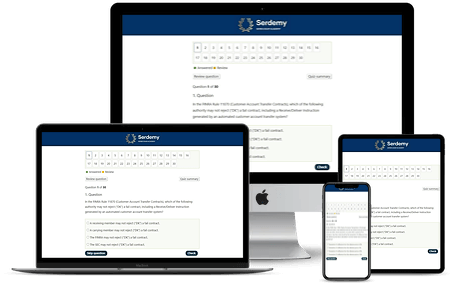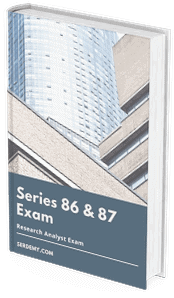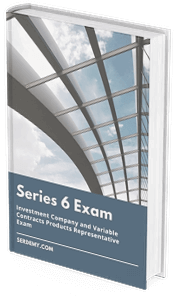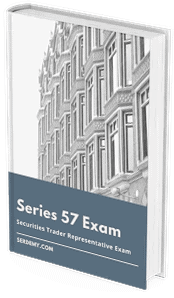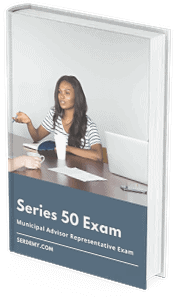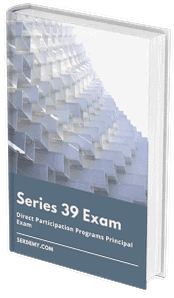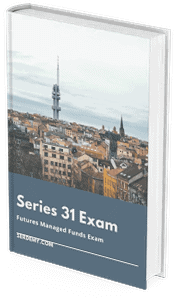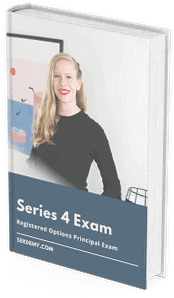Quiz-summary
0 of 30 questions completed
Questions:
- 1
- 2
- 3
- 4
- 5
- 6
- 7
- 8
- 9
- 10
- 11
- 12
- 13
- 14
- 15
- 16
- 17
- 18
- 19
- 20
- 21
- 22
- 23
- 24
- 25
- 26
- 27
- 28
- 29
- 30
Information
Premium Practice Questions
You have already completed the quiz before. Hence you can not start it again.
Quiz is loading...
You must sign in or sign up to start the quiz.
You have to finish following quiz, to start this quiz:
Results
0 of 30 questions answered correctly
Your time:
Time has elapsed
Categories
- Not categorized 0%
- 1
- 2
- 3
- 4
- 5
- 6
- 7
- 8
- 9
- 10
- 11
- 12
- 13
- 14
- 15
- 16
- 17
- 18
- 19
- 20
- 21
- 22
- 23
- 24
- 25
- 26
- 27
- 28
- 29
- 30
- Answered
- Review
-
Question 1 of 30
1. Question
An assessment of a draft research report for a large-cap pharmaceutical company reveals that the analyst’s “Buy” recommendation and price target are primarily derived from a discounted cash flow (DCF) model. As the reviewing Supervisory Analyst, you note that the analyst has used a perpetual terminal growth rate of 5% against a weighted average cost of capital of 10%. The report’s rationale for this growth rate is a brief statement about the company’s “strong pipeline and future market expansion.” What is the most critical issue that must be resolved to comply with FINRA Rule 2241 before this report can be approved for publication?
Correct
A core responsibility of a Supervisory Analyst is to ensure that any recommendation or price target in a research report has a reasonable basis, as mandated by FINRA Rule 2241. In a Discounted Cash Flow (DCF) valuation, the terminal value often constitutes a significant portion of the total valuation, and it is highly sensitive to the terminal growth rate and discount rate assumptions. Consider a DCF model where the final projected year’s free cash flow is $80 million, the Weighted Average Cost of Capital (WACC or discount rate, \(r\)) is 10%, and the analyst uses a perpetual terminal growth rate (\(g\)) of 5%. The calculation for the terminal value (TV) would be: \[ TV = \frac{\text{Final Year FCF} \times (1 + g)}{r – g} \] \[ TV = \frac{\$80,000,000 \times (1 + 0.05)}{0.10 – 0.05} = \frac{\$84,000,000}{0.05} = \$1,680,000,000 \] A terminal growth rate of 5% is exceptionally aggressive, as it implies the company will grow faster than the long-term nominal global economic growth rate forever, which is not a sustainable or reasonable assumption for most companies. If a more conventional terminal growth rate of 2.5% were used, the terminal value would be: \[ TV = \frac{\$80,000,000 \times (1 + 0.025)}{0.10 – 0.025} = \frac{\$82,000,000}{0.075} \approx \$1,093,333,333 \] The difference of over $586 million highlights how a single, unsupported assumption can drastically inflate the valuation. The Supervisory Analyst must challenge this 5% growth rate. Without a robust, specific, and well-documented justification for such an aggressive assumption, the resulting price target lacks a reasonable basis. The report must also clearly disclose the significant risks associated with this assumption. Failure to address this renders the report potentially misleading and not fair and balanced, in violation of FINRA rules.
Incorrect
A core responsibility of a Supervisory Analyst is to ensure that any recommendation or price target in a research report has a reasonable basis, as mandated by FINRA Rule 2241. In a Discounted Cash Flow (DCF) valuation, the terminal value often constitutes a significant portion of the total valuation, and it is highly sensitive to the terminal growth rate and discount rate assumptions. Consider a DCF model where the final projected year’s free cash flow is $80 million, the Weighted Average Cost of Capital (WACC or discount rate, \(r\)) is 10%, and the analyst uses a perpetual terminal growth rate (\(g\)) of 5%. The calculation for the terminal value (TV) would be: \[ TV = \frac{\text{Final Year FCF} \times (1 + g)}{r – g} \] \[ TV = \frac{\$80,000,000 \times (1 + 0.05)}{0.10 – 0.05} = \frac{\$84,000,000}{0.05} = \$1,680,000,000 \] A terminal growth rate of 5% is exceptionally aggressive, as it implies the company will grow faster than the long-term nominal global economic growth rate forever, which is not a sustainable or reasonable assumption for most companies. If a more conventional terminal growth rate of 2.5% were used, the terminal value would be: \[ TV = \frac{\$80,000,000 \times (1 + 0.025)}{0.10 – 0.025} = \frac{\$82,000,000}{0.075} \approx \$1,093,333,333 \] The difference of over $586 million highlights how a single, unsupported assumption can drastically inflate the valuation. The Supervisory Analyst must challenge this 5% growth rate. Without a robust, specific, and well-documented justification for such an aggressive assumption, the resulting price target lacks a reasonable basis. The report must also clearly disclose the significant risks associated with this assumption. Failure to address this renders the report potentially misleading and not fair and balanced, in violation of FINRA rules.
-
Question 2 of 30
2. Question
A Supervisory Analyst at Momentum Securities is reviewing a proposal from Anika, a research analyst covering the enterprise software sector. Momentum Securities served as a manager for the Initial Public Offering of InnovateSphere Inc., which priced and began trading \(8\) calendar days ago. Anika is scheduled to speak at a major industry conference in two days. Her proposal includes two components: first, a brief, pre-approved conversation with InnovateSphere’s CEO to clarify a non-GAAP metric from the company’s first public earnings release; and second, a slide in her presentation that lists key sector competitors, including InnovateSphere, along with their current market capitalizations. Based on FINRA rules, what is the correct determination the Supervisory Analyst must make regarding Anika’s proposed actions?
Correct
Under FINRA Rule 2241(b)(2)(I), a member firm that has acted as a manager or co-manager of an initial public offering (IPO) is prohibited from publishing a research report or allowing a research analyst to make a public appearance concerning the issuer for a period of 10 calendar days following the date of the offering. A public appearance is broadly defined and includes participating in a seminar, forum, or conference where the analyst makes a recommendation or offers an opinion concerning an equity security. In this scenario, the IPO priced 8 days ago, placing the proposed conference presentation squarely within this 10-day quiet period. Including InnovateSphere on a presentation slide, even with purely factual data like market capitalization, constitutes a public appearance concerning the issuer and is therefore prohibited. Furthermore, FINRA Rule 2241(c)(5) governs communications between research analysts and subject companies. To manage conflicts of interest, any such communications must be chaperoned by the firm’s legal or compliance personnel. This requirement is not waived for brief clarifications or because the information discussed is from a public filing. The chaperone’s role is to ensure the conversation remains appropriate and does not involve the receipt of material non-public information or attempts to influence the analyst’s views. Therefore, the Supervisory Analyst must conclude that the public appearance is prohibited due to the quiet period, and separately, any direct communication with the subject company’s management must be properly chaperoned.
Incorrect
Under FINRA Rule 2241(b)(2)(I), a member firm that has acted as a manager or co-manager of an initial public offering (IPO) is prohibited from publishing a research report or allowing a research analyst to make a public appearance concerning the issuer for a period of 10 calendar days following the date of the offering. A public appearance is broadly defined and includes participating in a seminar, forum, or conference where the analyst makes a recommendation or offers an opinion concerning an equity security. In this scenario, the IPO priced 8 days ago, placing the proposed conference presentation squarely within this 10-day quiet period. Including InnovateSphere on a presentation slide, even with purely factual data like market capitalization, constitutes a public appearance concerning the issuer and is therefore prohibited. Furthermore, FINRA Rule 2241(c)(5) governs communications between research analysts and subject companies. To manage conflicts of interest, any such communications must be chaperoned by the firm’s legal or compliance personnel. This requirement is not waived for brief clarifications or because the information discussed is from a public filing. The chaperone’s role is to ensure the conversation remains appropriate and does not involve the receipt of material non-public information or attempts to influence the analyst’s views. Therefore, the Supervisory Analyst must conclude that the public appearance is prohibited due to the quiet period, and separately, any direct communication with the subject company’s management must be properly chaperoned.
-
Question 3 of 30
3. Question
A Supervisory Analyst at a global investment bank is tasked with reviewing a complex situation. The bank is acting as a managing underwriter for the initial public offering (IPO) of a technology company’s common stock. Simultaneously, a fixed-income research analyst at the bank, who has no involvement with the equity underwriting team, has prepared a research report with a “Buy” recommendation on the same technology company’s outstanding, publicly-traded, non-convertible bonds. The firm regularly publishes research on corporate debt as part of its normal business operations. What is the most accurate determination the Supervisory Analyst should make regarding the publication of this bond research during the common stock IPO’s restricted period?
Correct
The core of this issue rests on the safe harbor provisions under the Securities Act of 1933 that permit broker-dealers to publish research even when they are involved in a distribution for the same issuer. The general rule, under Regulation M, is that a distribution participant cannot induce purchases of a covered security. However, specific exemptions exist. In this scenario, the firm is participating in a distribution of common stock. The research report in question covers the same issuer’s non-convertible debt securities. This situation is directly addressed by Securities Act Rule 138. This rule provides a safe harbor for a broker-dealer to publish or distribute research on an issuer’s securities when it is participating in a distribution of a different class of that issuer’s securities. Specifically, if the offering involves common stock, American Depositary Receipts, or convertible securities, the firm is permitted to publish research solely on the issuer’s non-convertible debt or non-convertible preferred stock. Conversely, if the offering is for non-convertible debt or non-convertible preferred stock, the firm can publish research on the issuer’s common stock or convertible securities. For the Rule 138 safe harbor to apply, the broker-dealer must have previously published or distributed research in the regular course of its business. The scenario establishes this condition is met. Therefore, despite the firm’s role as an underwriter for the common stock offering, publishing a research report on the company’s non-convertible bonds is a permissible activity. Rule 139 provides a different safe harbor for reports on the same type of security being offered, but Rule 138 is the more specific and applicable rule in this case involving different classes of securities.
Incorrect
The core of this issue rests on the safe harbor provisions under the Securities Act of 1933 that permit broker-dealers to publish research even when they are involved in a distribution for the same issuer. The general rule, under Regulation M, is that a distribution participant cannot induce purchases of a covered security. However, specific exemptions exist. In this scenario, the firm is participating in a distribution of common stock. The research report in question covers the same issuer’s non-convertible debt securities. This situation is directly addressed by Securities Act Rule 138. This rule provides a safe harbor for a broker-dealer to publish or distribute research on an issuer’s securities when it is participating in a distribution of a different class of that issuer’s securities. Specifically, if the offering involves common stock, American Depositary Receipts, or convertible securities, the firm is permitted to publish research solely on the issuer’s non-convertible debt or non-convertible preferred stock. Conversely, if the offering is for non-convertible debt or non-convertible preferred stock, the firm can publish research on the issuer’s common stock or convertible securities. For the Rule 138 safe harbor to apply, the broker-dealer must have previously published or distributed research in the regular course of its business. The scenario establishes this condition is met. Therefore, despite the firm’s role as an underwriter for the common stock offering, publishing a research report on the company’s non-convertible bonds is a permissible activity. Rule 139 provides a different safe harbor for reports on the same type of security being offered, but Rule 138 is the more specific and applicable rule in this case involving different classes of securities.
-
Question 4 of 30
4. Question
A Supervisory Analyst at Apex Global Markets, a large broker-dealer, is reviewing a proposed equity research report on Innovate Robotics Corp., a company that files reports under the Securities Exchange Act of 1934. The analyst has maintained regular coverage on Innovate Robotics for several years. Apex is concurrently acting as a managing underwriter for a new public offering of Innovate Robotics’ non-convertible, investment-grade debt securities. The Supervisory Analyst must determine if publishing the equity research report is permissible. Under which specific condition or safe harbor would the publication of the equity research report most likely be permissible during the debt offering’s distribution period?
Correct
The analysis begins by identifying the core regulatory conflict: a broker-dealer participating in a securities distribution wants to publish research on the same issuer. The general principle, governed by rules like Regulation M and FINRA Rule 2241, is to restrict such communications to prevent market manipulation or “gun-jumping” during the offering period. However, the Securities Act of 1933 provides specific safe harbors that permit the publication of research under certain conditions, recognizing the value of ongoing research dissemination to the market. The key is to determine which, if any, safe harbor applies to the specific facts. The firm is underwriting a distribution of non-convertible debt securities. The research report covers the issuer’s common stock. These are fundamentally different types of securities. Securities Act Rule 137 is inapplicable because it only applies to brokers or dealers who are not participating in the distribution. The firm in this scenario is a managing underwriter and thus a distribution participant. Securities Act Rule 139 provides a safe harbor for research, but it is primarily designed for situations where the research covers the same class of securities being offered or is part of a comprehensive report covering many companies. Securities Act Rule 138 provides a more specific and appropriate safe harbor for this exact situation. Rule 138 permits a broker-dealer participating in a distribution of an issuer’s non-convertible securities (like the debt in this case) to publish research that is solely about the issuer’s common stock or other equity securities. The reverse is also true. The primary conditions for this safe harbor are that the issuer must be a reporting company under the Securities Exchange Act of 1934 and the broker-dealer must publish or distribute such research in the regular course of its business. The scenario indicates both conditions are met. Therefore, the publication is permissible under the Rule 138 safe harbor, which provides an exception to the general prohibitions of Regulation M and FINRA’s quiet period rules.
Incorrect
The analysis begins by identifying the core regulatory conflict: a broker-dealer participating in a securities distribution wants to publish research on the same issuer. The general principle, governed by rules like Regulation M and FINRA Rule 2241, is to restrict such communications to prevent market manipulation or “gun-jumping” during the offering period. However, the Securities Act of 1933 provides specific safe harbors that permit the publication of research under certain conditions, recognizing the value of ongoing research dissemination to the market. The key is to determine which, if any, safe harbor applies to the specific facts. The firm is underwriting a distribution of non-convertible debt securities. The research report covers the issuer’s common stock. These are fundamentally different types of securities. Securities Act Rule 137 is inapplicable because it only applies to brokers or dealers who are not participating in the distribution. The firm in this scenario is a managing underwriter and thus a distribution participant. Securities Act Rule 139 provides a safe harbor for research, but it is primarily designed for situations where the research covers the same class of securities being offered or is part of a comprehensive report covering many companies. Securities Act Rule 138 provides a more specific and appropriate safe harbor for this exact situation. Rule 138 permits a broker-dealer participating in a distribution of an issuer’s non-convertible securities (like the debt in this case) to publish research that is solely about the issuer’s common stock or other equity securities. The reverse is also true. The primary conditions for this safe harbor are that the issuer must be a reporting company under the Securities Exchange Act of 1934 and the broker-dealer must publish or distribute such research in the regular course of its business. The scenario indicates both conditions are met. Therefore, the publication is permissible under the Rule 138 safe harbor, which provides an exception to the general prohibitions of Regulation M and FINRA’s quiet period rules.
-
Question 5 of 30
5. Question
A supervisory analyst, Kenji, is reviewing the documentation for a research analyst, Anika, who is scheduled for a public appearance on a financial news program to discuss her coverage of Innovatech Corp. Anika’s notes from a pre-interview call with the show’s producer indicate that she confirmed her existing “Buy” rating and price target, which are consistent with her most recent published report. However, her notes also state she mentioned that a “preliminary internal model adjustment, not yet finalized for a report, suggests a slight upward revision to next year’s earnings forecast.” From a compliance perspective under FINRA Rule 2241, what is Kenji’s most significant and immediate concern?
Correct
The primary compliance concern for the Supervisory Analyst is the research analyst’s communication of a new, albeit preliminary, change in her earnings forecast to a third party before that information has been disseminated in a research report available to the firm’s clients. FINRA Rule 2241, which governs research analysts and research reports, is designed to promote the integrity of research and manage conflicts of interest. A core principle of this rule and associated regulations like Regulation FD is the concept of fair dissemination. When an analyst develops a new or changed view, rating, or price target, that information must be shared with the firm’s clients through a formal research report before or concurrent with its disclosure to others. By mentioning the unreleased internal model adjustment that raises her earnings forecast, the analyst has selectively disclosed a material change in her analysis. Even though she qualified it as “preliminary,” this information could influence the media program’s content and provides an informational advantage to the producer and potentially the show’s audience over the firm’s own clients. This action undermines the requirement for research to be distributed in a fair and balanced manner. The Supervisory Analyst’s role includes ensuring that public appearances are not used to front-run the firm’s own research publications. The analyst must be instructed to only discuss views and analyses that have been previously published and are supported by a reasonable basis documented in a distributed report. Any new analysis must first be vetted, approved, and published according to firm policies and regulatory requirements.
Incorrect
The primary compliance concern for the Supervisory Analyst is the research analyst’s communication of a new, albeit preliminary, change in her earnings forecast to a third party before that information has been disseminated in a research report available to the firm’s clients. FINRA Rule 2241, which governs research analysts and research reports, is designed to promote the integrity of research and manage conflicts of interest. A core principle of this rule and associated regulations like Regulation FD is the concept of fair dissemination. When an analyst develops a new or changed view, rating, or price target, that information must be shared with the firm’s clients through a formal research report before or concurrent with its disclosure to others. By mentioning the unreleased internal model adjustment that raises her earnings forecast, the analyst has selectively disclosed a material change in her analysis. Even though she qualified it as “preliminary,” this information could influence the media program’s content and provides an informational advantage to the producer and potentially the show’s audience over the firm’s own clients. This action undermines the requirement for research to be distributed in a fair and balanced manner. The Supervisory Analyst’s role includes ensuring that public appearances are not used to front-run the firm’s own research publications. The analyst must be instructed to only discuss views and analyses that have been previously published and are supported by a reasonable basis documented in a distributed report. Any new analysis must first be vetted, approved, and published according to firm policies and regulatory requirements.
-
Question 6 of 30
6. Question
Kenji, a Supervisory Analyst at Vanguard Capital, is reviewing a request from one of his firm’s analysts to publish a new research report with a “Buy” rating on AeroDynamic Solutions. AeroDynamic Solutions, an Emerging Growth Company (EGC), filed a registration statement for its Initial Public Offering (IPO) last week. Vanguard Capital is not, and has not been, named as a manager, co-manager, underwriter, or selling group member for the IPO. The analyst has covered the aerospace sector for five years and regularly publishes reports. What is the most accurate determination Kenji should make regarding the permissibility of publishing this research report?
Correct
The determination is made through a logical analysis of the applicable regulations, not a numerical calculation. 1. Identify the firm’s role: Vanguard Capital is not a participant in the distribution (i.e., not an underwriter or selling group member) for AeroDynamic Solutions’ IPO. 2. Identify the regulatory context: A company is in registration for an IPO, which typically triggers restrictions on communications that could be deemed an “offer.” 3. Evaluate FINRA Rule 2241 quiet periods: The quiet periods (10 days for managers, 3 days for other participants) apply to firms participating in the offering. Since Vanguard Capital is not participating, these specific quiet periods do not apply to it. 4. Evaluate SEC Safe Harbors: – Rule 139: This rule provides a safe harbor for research reports published by a broker-dealer that *is* a participant in the distribution. This is not applicable to Vanguard Capital. – Rule 137: This rule provides a specific safe harbor for broker-dealers that are *not* participating in a distribution. It states that the distribution of research reports by such a dealer will not be considered an “offer for sale” or “offer to sell” a security, and therefore not a prospectus, if certain conditions are met. The primary condition is that the broker-dealer publishes or distributes such information in the regular course of its business and receives no compensation for it from the issuer or other distribution participants, other than the regular subscription or sale price of the report. 5. Conclusion: Based on the facts, Vanguard Capital’s proposed research report falls directly under the safe harbor provided by Securities Act Rule 137. The fact that the issuer is an EGC provides additional relief from certain rules (like the FINRA quiet period), but the fundamental provision permitting a non-participating dealer to issue research is Rule 137. Securities Act Rule 137 is a critical safe harbor provision that a Supervisory Analyst must understand. Its purpose is to permit the continued publication of research by firms that are not involved in an issuer’s registered offering of securities. Without this rule, the normal flow of information and analysis to the marketplace could be severely restricted every time a company enters registration, creating an information vacuum. The rule ensures that a broker-dealer’s routine, independent research is not inadvertently classified as an illegal offer or prospectus under Section 5 of the Securities Act of 1933. To qualify for this safe harbor, the broker-dealer must be publishing the research in the regular course of its business and must not have received any special consideration or compensation from the issuer, a selling security holder, or any other participant in the distribution. It is distinct from Rule 138, which applies to research on different classes of an issuer’s securities, and Rule 139, which applies specifically to broker-dealers who are participating in the distribution. A Supervisory Analyst must be able to differentiate these rules to correctly advise on the permissibility of publishing research during a registration period.
Incorrect
The determination is made through a logical analysis of the applicable regulations, not a numerical calculation. 1. Identify the firm’s role: Vanguard Capital is not a participant in the distribution (i.e., not an underwriter or selling group member) for AeroDynamic Solutions’ IPO. 2. Identify the regulatory context: A company is in registration for an IPO, which typically triggers restrictions on communications that could be deemed an “offer.” 3. Evaluate FINRA Rule 2241 quiet periods: The quiet periods (10 days for managers, 3 days for other participants) apply to firms participating in the offering. Since Vanguard Capital is not participating, these specific quiet periods do not apply to it. 4. Evaluate SEC Safe Harbors: – Rule 139: This rule provides a safe harbor for research reports published by a broker-dealer that *is* a participant in the distribution. This is not applicable to Vanguard Capital. – Rule 137: This rule provides a specific safe harbor for broker-dealers that are *not* participating in a distribution. It states that the distribution of research reports by such a dealer will not be considered an “offer for sale” or “offer to sell” a security, and therefore not a prospectus, if certain conditions are met. The primary condition is that the broker-dealer publishes or distributes such information in the regular course of its business and receives no compensation for it from the issuer or other distribution participants, other than the regular subscription or sale price of the report. 5. Conclusion: Based on the facts, Vanguard Capital’s proposed research report falls directly under the safe harbor provided by Securities Act Rule 137. The fact that the issuer is an EGC provides additional relief from certain rules (like the FINRA quiet period), but the fundamental provision permitting a non-participating dealer to issue research is Rule 137. Securities Act Rule 137 is a critical safe harbor provision that a Supervisory Analyst must understand. Its purpose is to permit the continued publication of research by firms that are not involved in an issuer’s registered offering of securities. Without this rule, the normal flow of information and analysis to the marketplace could be severely restricted every time a company enters registration, creating an information vacuum. The rule ensures that a broker-dealer’s routine, independent research is not inadvertently classified as an illegal offer or prospectus under Section 5 of the Securities Act of 1933. To qualify for this safe harbor, the broker-dealer must be publishing the research in the regular course of its business and must not have received any special consideration or compensation from the issuer, a selling security holder, or any other participant in the distribution. It is distinct from Rule 138, which applies to research on different classes of an issuer’s securities, and Rule 139, which applies specifically to broker-dealers who are participating in the distribution. A Supervisory Analyst must be able to differentiate these rules to correctly advise on the permissibility of publishing research during a registration period.
-
Question 7 of 30
7. Question
A FINRA member firm, Polaris Wealth Management, has an agreement to distribute research reports created by an unaffiliated, independent research provider, Zenith Analytics. A Polaris research analyst, Priya, reviews a new report from Zenith that assigns a “Speculative Buy” to a small-cap biotech firm. The sales team asks Priya to send a note to institutional clients about the report. Priya drafts an email stating, “We concur with Zenith Analytics’ ‘Speculative Buy’ rating on BioGen Innovations and believe their analysis of the Phase II trial data is particularly insightful.” As the Supervisory Analyst responsible for approving Priya’s communications, what is the most critical determination you must make under FINRA rules and SEC regulations?
Correct
The core determination is whether the analyst’s commentary causes the firm to “adopt” the third-party research as its own. Under FINRA Rule 2241, if a member firm or its analyst explicitly or implicitly endorses, approves, or selectively highlights positive aspects of a third-party research report, that communication is considered to have been adopted by the firm. When adoption occurs, the communication itself becomes a research report of the member firm. Consequently, it is subject to all the same regulatory requirements as if the firm had produced the report from scratch. This includes principal approval by a Supervisory Analyst, the inclusion of all standard disclosures required by Rule 2241 (such as the meaning of ratings, valuation methods, conflicts of interest), and a certification by the analyst under SEC Regulation AC stating that the views expressed are their own. Simply distributing an independent third-party report without commentary carries fewer obligations. However, the act of adding substantive commentary, agreement, or highlights transforms the communication and triggers a full suite of compliance duties for the Supervisory Analyst to enforce. The primary task is therefore to analyze the nature of the commentary to see if it crosses the line into adoption, which then dictates all subsequent review and disclosure steps.
Incorrect
The core determination is whether the analyst’s commentary causes the firm to “adopt” the third-party research as its own. Under FINRA Rule 2241, if a member firm or its analyst explicitly or implicitly endorses, approves, or selectively highlights positive aspects of a third-party research report, that communication is considered to have been adopted by the firm. When adoption occurs, the communication itself becomes a research report of the member firm. Consequently, it is subject to all the same regulatory requirements as if the firm had produced the report from scratch. This includes principal approval by a Supervisory Analyst, the inclusion of all standard disclosures required by Rule 2241 (such as the meaning of ratings, valuation methods, conflicts of interest), and a certification by the analyst under SEC Regulation AC stating that the views expressed are their own. Simply distributing an independent third-party report without commentary carries fewer obligations. However, the act of adding substantive commentary, agreement, or highlights transforms the communication and triggers a full suite of compliance duties for the Supervisory Analyst to enforce. The primary task is therefore to analyze the nature of the commentary to see if it crosses the line into adoption, which then dictates all subsequent review and disclosure steps.
-
Question 8 of 30
8. Question
Anya, a research analyst at a FINRA member firm, has just completed a comprehensive research report on Innovate Robotics Corp., which includes a newly initiated “Buy” rating and a 12-month price target. Before the report is published, her firm’s procedures, which are designed to comply with FINRA Rule 2241, allow her to send a draft to Innovate Robotics for the sole purpose of verifying factual information. Anya informs her Supervisory Analyst, David, that she intends to email the complete draft report to Innovate Robotics’ CFO and that she is also scheduled to discuss her sector outlook, including her general views on Innovate Robotics, at an industry conference in two days. Given this sequence of events, what is the most critical compliance action David must immediately undertake?
Correct
The core responsibility of a Supervisory Analyst under FINRA Rule 2241 is to ensure the objectivity and integrity of research and to manage potential conflicts of interest. A critical aspect of this is controlling the flow of information between the research analyst and the subject company. While firms may permit analysts to submit draft research reports to subject companies for the limited purpose of verifying factual accuracy, this process is strictly regulated. Specifically, FINRA Rule 2241(c)(4)(D) explicitly prohibits the inclusion of the research summary, the research rating, or the price target in any draft report sent to a subject company. The rationale is to prevent the subject company from attempting to influence the analyst’s core conclusions and to avoid the selective disclosure of the most market-sensitive components of the report before they are publicly disseminated. Allowing the rating or price target to be shared with the company before publication could constitute a serious breach of Regulation FD and FINRA rules regarding fair and equitable information dissemination. Therefore, the Supervisory Analyst’s primary and most immediate duty in this situation is to ensure that the draft is properly redacted to remove these prohibited sections before it is sent to the subject company for its factual review. This action directly mitigates the risk of undue influence and selective disclosure.
Incorrect
The core responsibility of a Supervisory Analyst under FINRA Rule 2241 is to ensure the objectivity and integrity of research and to manage potential conflicts of interest. A critical aspect of this is controlling the flow of information between the research analyst and the subject company. While firms may permit analysts to submit draft research reports to subject companies for the limited purpose of verifying factual accuracy, this process is strictly regulated. Specifically, FINRA Rule 2241(c)(4)(D) explicitly prohibits the inclusion of the research summary, the research rating, or the price target in any draft report sent to a subject company. The rationale is to prevent the subject company from attempting to influence the analyst’s core conclusions and to avoid the selective disclosure of the most market-sensitive components of the report before they are publicly disseminated. Allowing the rating or price target to be shared with the company before publication could constitute a serious breach of Regulation FD and FINRA rules regarding fair and equitable information dissemination. Therefore, the Supervisory Analyst’s primary and most immediate duty in this situation is to ensure that the draft is properly redacted to remove these prohibited sections before it is sent to the subject company for its factual review. This action directly mitigates the risk of undue influence and selective disclosure.
-
Question 9 of 30
9. Question
An assessment of a draft research report for a software company, “InnovateSphere Inc.” (ISI), is being conducted by Priya, a Supervisory Analyst. The research analyst, Kenji, has initiated coverage with a “Strong Buy” rating and a price target suggesting significant upside. The report’s central thesis and valuation are almost exclusively derived from a proprietary, non-GAAP metric Kenji created called “Adjusted Customer Engagement Value” (ACEV). The report prominently displays the ACEV and a valuation based on an ACEV-to-price multiple. A reconciliation of ACEV to the most comparable GAAP measure, net income, is included but is located within a footnote near the end of the report. As the Supervisory Analyst, Priya’s primary regulatory concern should be that the report:
Correct
The core issue in this scenario involves the proper use and presentation of non-GAAP financial measures in research reports, which is governed by SEC Regulation G and reinforced by FINRA’s rules on fair and balanced communications. Regulation G permits the use of non-GAAP measures but mandates that the most directly comparable GAAP measure must be presented with equal or greater prominence. It also requires a clear reconciliation between the non-GAAP measure and the most comparable GAAP measure. In the described report, the custom “Adjusted Customer Engagement Value” (ACEV) metric is given top billing, with the valuation and recommendation hinging almost entirely upon it. The comparable GAAP measure, net income, is relegated to a footnote. This presentation gives undue prominence to the non-GAAP metric, which is a direct violation of Regulation G. Furthermore, FINRA Rule 2241 requires that all recommendations in a research report have a reasonable basis. A valuation methodology that relies almost exclusively on a proprietary, unproven, and non-standard metric like ACEV, without a strong link to established valuation principles or a thorough justification for its superiority, would likely be deemed to lack a reasonable basis. The Supervisory Analyst’s duty is to ensure that the analytical framework is sound and the conclusions are well-supported by credible evidence and methods. The over-reliance on a custom metric, especially one presented in a non-compliant manner, undermines the report’s credibility and fails the reasonable basis test. Therefore, the combination of the Regulation G violation and the resulting lack of a reasonable basis under FINRA Rule 2241 constitutes the most significant regulatory failure that the Supervisory Analyst must address.
Incorrect
The core issue in this scenario involves the proper use and presentation of non-GAAP financial measures in research reports, which is governed by SEC Regulation G and reinforced by FINRA’s rules on fair and balanced communications. Regulation G permits the use of non-GAAP measures but mandates that the most directly comparable GAAP measure must be presented with equal or greater prominence. It also requires a clear reconciliation between the non-GAAP measure and the most comparable GAAP measure. In the described report, the custom “Adjusted Customer Engagement Value” (ACEV) metric is given top billing, with the valuation and recommendation hinging almost entirely upon it. The comparable GAAP measure, net income, is relegated to a footnote. This presentation gives undue prominence to the non-GAAP metric, which is a direct violation of Regulation G. Furthermore, FINRA Rule 2241 requires that all recommendations in a research report have a reasonable basis. A valuation methodology that relies almost exclusively on a proprietary, unproven, and non-standard metric like ACEV, without a strong link to established valuation principles or a thorough justification for its superiority, would likely be deemed to lack a reasonable basis. The Supervisory Analyst’s duty is to ensure that the analytical framework is sound and the conclusions are well-supported by credible evidence and methods. The over-reliance on a custom metric, especially one presented in a non-compliant manner, undermines the report’s credibility and fails the reasonable basis test. Therefore, the combination of the Regulation G violation and the resulting lack of a reasonable basis under FINRA Rule 2241 constitutes the most significant regulatory failure that the Supervisory Analyst must address.
-
Question 10 of 30
10. Question
Apex Capital is a manager for the upcoming Initial Public Offering (IPO) of Quantum Dynamics Inc., a firm in the quantum computing sector. The IPO is scheduled to price in two weeks. Kenji, a research analyst at Apex Capital who covers the advanced technology sector, has prepared a new research report with a “Buy” rating on Photon Systems, an established public company and a direct competitor to Quantum Dynamics. Kenji submits this report to Amara, the firm’s Supervisory Analyst, for approval prior to publication. Assessment of this situation indicates a potential conflict between the firm’s investment banking activities and its research dissemination. For Amara to approve the publication of the research report on Photon Systems, which of the following is the most critical determination she must make under FINRA Rule 2241 and related SEC regulations?
Correct
The core issue revolves around the application of research quiet periods as mandated by FINRA Rule 2241 and the general anti-manipulation provisions of securities regulations. FINRA Rule 2241(f) establishes a quiet period of 10 calendar days following the date of an initial public offering (IPO) during which a member firm that acted as a manager or co-manager may not publish or distribute a research report concerning the subject company. A key point of this rule is that it applies specifically to the subject company of the offering, which in this scenario is Quantum Dynamics Inc. The research report in question is about a different company, Photon Systems, which is a competitor. Therefore, the 10-day quiet period does not technically or explicitly prohibit the publication of the report on Photon Systems. However, a Supervisory Analyst’s duty extends beyond a literal reading of the quiet period rule. The SA must consider the broader context and potential for market manipulation under rules like FINRA Rule 2020 and Section 9 of the Securities Exchange Act of 1934. The primary risk is that the report on the competitor could be used as a surrogate or proxy to “prime the market” or indirectly generate excitement for the IPO by hyping the industry. The SA’s most critical task is to perform heightened diligence to ensure this is not the case. This involves verifying that the report on Photon Systems is a bona fide piece of research, consistent with the analyst’s regular coverage of the sector, and not initiated specifically to coincide with the IPO. The SA must meticulously review the report to ensure it is fair, balanced, not promissory, and does not contain veiled references or exaggerated claims about the industry that could be construed as promoting the Quantum Dynamics offering. The analysis must stand on its own merits, and the SA must be satisfied that its timing and content are not a manipulative tactic.
Incorrect
The core issue revolves around the application of research quiet periods as mandated by FINRA Rule 2241 and the general anti-manipulation provisions of securities regulations. FINRA Rule 2241(f) establishes a quiet period of 10 calendar days following the date of an initial public offering (IPO) during which a member firm that acted as a manager or co-manager may not publish or distribute a research report concerning the subject company. A key point of this rule is that it applies specifically to the subject company of the offering, which in this scenario is Quantum Dynamics Inc. The research report in question is about a different company, Photon Systems, which is a competitor. Therefore, the 10-day quiet period does not technically or explicitly prohibit the publication of the report on Photon Systems. However, a Supervisory Analyst’s duty extends beyond a literal reading of the quiet period rule. The SA must consider the broader context and potential for market manipulation under rules like FINRA Rule 2020 and Section 9 of the Securities Exchange Act of 1934. The primary risk is that the report on the competitor could be used as a surrogate or proxy to “prime the market” or indirectly generate excitement for the IPO by hyping the industry. The SA’s most critical task is to perform heightened diligence to ensure this is not the case. This involves verifying that the report on Photon Systems is a bona fide piece of research, consistent with the analyst’s regular coverage of the sector, and not initiated specifically to coincide with the IPO. The SA must meticulously review the report to ensure it is fair, balanced, not promissory, and does not contain veiled references or exaggerated claims about the industry that could be construed as promoting the Quantum Dynamics offering. The analysis must stand on its own merits, and the SA must be satisfied that its timing and content are not a manipulative tactic.
-
Question 11 of 30
11. Question
A Supervisory Analyst, Leo, at a broker-dealer that is the lead underwriter for AeroDynamic Solutions’ upcoming IPO, is reviewing a request from Priya, one of the firm’s research analysts. A registration statement for the IPO has been filed with the SEC but is not yet effective. Priya has prepared a comprehensive research report with a “Buy” rating and a price target for AeroDynamic. She wants to publish it immediately to give the firm’s clients a competitive advantage. Furthermore, Priya notes that her analysis was enhanced by a private conversation with AeroDynamic’s CFO, who provided clarifying details on new technology not fully detailed in the preliminary prospectus. What is the most significant and immediate regulatory prohibition that Leo must address in this situation?
Correct
The core issue is the prohibition on a participating underwriter publishing research during the IPO quiet period, which constitutes “gun-jumping” under the Securities Act of 1933. 1. Identify the firm’s role: The firm is the lead underwriter for an Initial Public Offering (IPO). 2. Identify the offering stage: A registration statement has been filed but is not yet effective. This is the “waiting period” or “quiet period.” 3. Identify the proposed action: An analyst at the underwriting firm intends to publish a research report on the issuer. 4. Apply governing regulations: – Section 5 of the Securities Act of 1933 prohibits conditioning the market, or “gun-jumping,” during the waiting period. A research report from a participating underwriter is considered an illegal offer to sell, as it is outside the scope of the permissible preliminary prospectus (red herring). – FINRA Rule 2241(f) establishes a specific quiet period for IPOs, prohibiting a firm that has acted as a manager or co-manager from publishing or distributing a research report for 10 calendar days following the date of the offering. While the proposed action is before the offering date, it violates the spirit and letter of the law aimed at preventing market conditioning. – The safe harbors provided by Rules 137, 138, and 139 of the Securities Act are not applicable. Rule 139, which allows for research publication by distributors under certain conditions, specifically does not apply to IPOs. 5. Conclusion: The primary and most severe violation is the proposed publication of the research report itself, as it is a prohibited act for an underwriter during the IPO registration process. The role of a Supervisory Analyst is to ensure compliance with all applicable securities laws and FINRA rules. In the context of an Initial Public Offering, the period after a registration statement is filed with the SEC but before it becomes effective is known as the waiting period, or quiet period. During this time, strict limitations are placed on communications to prevent “gun-jumping,” which is the illegal conditioning of the market for the new securities. Section 5 of the Securities Act of 1933 governs these activities. A research report issued by a firm participating in the distribution, such as a lead underwriter, is considered an illegal prospectus and an unlawful offer to sell. FINRA Rule 2241 codifies specific quiet periods, including a 10-day period after an IPO for managers and co-managers. While the scenario occurs before the effective date, the principle of preventing pre-effective market conditioning is paramount. Safe harbor provisions like Rule 139, which permit research under certain circumstances for seasoned issuers, are explicitly not available for IPOs. While other compliance issues like Regulation FD (selective disclosure from the CFO) and Regulation AC (analyst certification) are present, they are secondary to the absolute prohibition against the underwriter publishing research during this sensitive period. The most critical responsibility for the Supervisory Analyst is to prevent the firm from committing a direct violation of securities law by publishing the report.
Incorrect
The core issue is the prohibition on a participating underwriter publishing research during the IPO quiet period, which constitutes “gun-jumping” under the Securities Act of 1933. 1. Identify the firm’s role: The firm is the lead underwriter for an Initial Public Offering (IPO). 2. Identify the offering stage: A registration statement has been filed but is not yet effective. This is the “waiting period” or “quiet period.” 3. Identify the proposed action: An analyst at the underwriting firm intends to publish a research report on the issuer. 4. Apply governing regulations: – Section 5 of the Securities Act of 1933 prohibits conditioning the market, or “gun-jumping,” during the waiting period. A research report from a participating underwriter is considered an illegal offer to sell, as it is outside the scope of the permissible preliminary prospectus (red herring). – FINRA Rule 2241(f) establishes a specific quiet period for IPOs, prohibiting a firm that has acted as a manager or co-manager from publishing or distributing a research report for 10 calendar days following the date of the offering. While the proposed action is before the offering date, it violates the spirit and letter of the law aimed at preventing market conditioning. – The safe harbors provided by Rules 137, 138, and 139 of the Securities Act are not applicable. Rule 139, which allows for research publication by distributors under certain conditions, specifically does not apply to IPOs. 5. Conclusion: The primary and most severe violation is the proposed publication of the research report itself, as it is a prohibited act for an underwriter during the IPO registration process. The role of a Supervisory Analyst is to ensure compliance with all applicable securities laws and FINRA rules. In the context of an Initial Public Offering, the period after a registration statement is filed with the SEC but before it becomes effective is known as the waiting period, or quiet period. During this time, strict limitations are placed on communications to prevent “gun-jumping,” which is the illegal conditioning of the market for the new securities. Section 5 of the Securities Act of 1933 governs these activities. A research report issued by a firm participating in the distribution, such as a lead underwriter, is considered an illegal prospectus and an unlawful offer to sell. FINRA Rule 2241 codifies specific quiet periods, including a 10-day period after an IPO for managers and co-managers. While the scenario occurs before the effective date, the principle of preventing pre-effective market conditioning is paramount. Safe harbor provisions like Rule 139, which permit research under certain circumstances for seasoned issuers, are explicitly not available for IPOs. While other compliance issues like Regulation FD (selective disclosure from the CFO) and Regulation AC (analyst certification) are present, they are secondary to the absolute prohibition against the underwriter publishing research during this sensitive period. The most critical responsibility for the Supervisory Analyst is to prevent the firm from committing a direct violation of securities law by publishing the report.
-
Question 12 of 30
12. Question
An assessment of a draft research report on a publicly traded software company, Zenith Dynamics Inc., reveals a complex contribution structure. Kenji, a senior analyst, is the sole named author and is responsible for the overall investment thesis and final recommendation. However, Maria, a junior analyst working under Kenji, independently developed the comprehensive discounted cash flow model and authored the entire 10-page valuation section of the report. This section forms the primary quantitative basis for the price target set by Kenji. As the Supervisory Analyst reviewing the report for compliance with FINRA Rule 2241 and Regulation AC, what is your primary obligation regarding Maria’s contribution before approving the report for publication?
Correct
The core issue revolves around the definition of a “research analyst” under FINRA Rule 2241 and the corresponding certification requirements of Regulation AC. These rules are not limited to individuals formally named as authors on a report’s cover page. Regulation AC requires that a research report include a certification from the research analyst(s) who prepared it, stating that the views expressed accurately reflect their personal views. FINRA Rule 2241(a)(11) provides a broad definition of a “research analyst” as an associated person primarily responsible for preparing the substance of a research report, and any associated person who reports to them in connection with that preparation. In this scenario, the junior analyst developed the entire financial model and wrote the valuation section. This constitutes a substantial portion of the report’s content and is the direct basis for the price target and recommendation. Therefore, for the purposes of these rules, the junior analyst is considered a research analyst with respect to this specific report. The senior analyst’s certification alone is insufficient because it does not cover the personal views of the other individual who prepared a significant part of the analysis. The Supervisory Analyst’s duty is to ensure full compliance. This requires obtaining a separate Regulation AC certification from the junior analyst. Furthermore, all disclosures required for a research analyst under FINRA Rule 2241, such as any financial interest in the subject company or relevant compensation arrangements, must also be made for the junior analyst within the report. Simply documenting the contribution internally or relying on the lead analyst’s signature fails to meet the explicit requirements for transparency and accountability mandated by both FINRA and the SEC.
Incorrect
The core issue revolves around the definition of a “research analyst” under FINRA Rule 2241 and the corresponding certification requirements of Regulation AC. These rules are not limited to individuals formally named as authors on a report’s cover page. Regulation AC requires that a research report include a certification from the research analyst(s) who prepared it, stating that the views expressed accurately reflect their personal views. FINRA Rule 2241(a)(11) provides a broad definition of a “research analyst” as an associated person primarily responsible for preparing the substance of a research report, and any associated person who reports to them in connection with that preparation. In this scenario, the junior analyst developed the entire financial model and wrote the valuation section. This constitutes a substantial portion of the report’s content and is the direct basis for the price target and recommendation. Therefore, for the purposes of these rules, the junior analyst is considered a research analyst with respect to this specific report. The senior analyst’s certification alone is insufficient because it does not cover the personal views of the other individual who prepared a significant part of the analysis. The Supervisory Analyst’s duty is to ensure full compliance. This requires obtaining a separate Regulation AC certification from the junior analyst. Furthermore, all disclosures required for a research analyst under FINRA Rule 2241, such as any financial interest in the subject company or relevant compensation arrangements, must also be made for the junior analyst within the report. Simply documenting the contribution internally or relying on the lead analyst’s signature fails to meet the explicit requirements for transparency and accountability mandated by both FINRA and the SEC.
-
Question 13 of 30
13. Question
A supervisory analyst at a mid-sized broker-dealer, Stellar Securities, is reviewing a request from Kenji, a respected analyst. VoltDrive, a private domestic company, has just filed its S-1 registration statement for an Initial Public Offering (IPO). Stellar Securities is not, and will not be, a participant in the underwriting syndicate for the VoltDrive IPO. Kenji, who covers the relevant industry, has prepared a detailed research report on VoltDrive that includes a “Buy” recommendation and a specific price target. He wants to publish this report immediately. What is the correct determination for the supervisory analyst to make regarding the publication of Kenji’s report?
Correct
The core issue revolves around the regulations governing the publication of research during a securities offering, specifically under the Securities Act of 1933. Section 5 of this Act restricts communications that could be construed as an “offer to sell” a security before the registration statement is effective, a period often called the waiting period. This is to prevent “gun-jumping,” which is the conditioning of the market for the new issue. FINRA and SEC rules provide certain safe harbors that allow broker-dealers to continue publishing research without it being deemed a prohibited offer. Rule 137 of the Securities Act of 1933 is a key safe harbor for broker-dealers who are not participating in the distribution of securities. It permits them to publish research reports on an issuer that is in registration. However, this safe harbor has critical conditions. The most important condition for a domestic issuer is that the company must be subject to the reporting requirements of Section 13 or 15(d) of the Securities Exchange Act of 1934. An issuer conducting an Initial Public Offering (IPO) has filed a registration statement under the ’33 Act but is not yet a ’34 Act reporting company. Therefore, the Rule 137 safe harbor is not available for research on the specific security being offered in the IPO. Publishing a research report with a recommendation and price target on the IPO issuer during the waiting period would be a violation of Section 5 of the ’33 Act. The supervisory analyst must prohibit such a publication to ensure compliance.
Incorrect
The core issue revolves around the regulations governing the publication of research during a securities offering, specifically under the Securities Act of 1933. Section 5 of this Act restricts communications that could be construed as an “offer to sell” a security before the registration statement is effective, a period often called the waiting period. This is to prevent “gun-jumping,” which is the conditioning of the market for the new issue. FINRA and SEC rules provide certain safe harbors that allow broker-dealers to continue publishing research without it being deemed a prohibited offer. Rule 137 of the Securities Act of 1933 is a key safe harbor for broker-dealers who are not participating in the distribution of securities. It permits them to publish research reports on an issuer that is in registration. However, this safe harbor has critical conditions. The most important condition for a domestic issuer is that the company must be subject to the reporting requirements of Section 13 or 15(d) of the Securities Exchange Act of 1934. An issuer conducting an Initial Public Offering (IPO) has filed a registration statement under the ’33 Act but is not yet a ’34 Act reporting company. Therefore, the Rule 137 safe harbor is not available for research on the specific security being offered in the IPO. Publishing a research report with a recommendation and price target on the IPO issuer during the waiting period would be a violation of Section 5 of the ’33 Act. The supervisory analyst must prohibit such a publication to ensure compliance.
-
Question 14 of 30
14. Question
An assessment of a pending research publication at Keystone Capital requires a nuanced understanding of regulatory safe harbors. Keystone is acting as a managing underwriter for a secondary offering of non-convertible, investment-grade bonds issued by AeroDynamics Inc., a company that qualifies to use Form S-3 for registrations. Keystone’s research department, which has published quarterly reports on AeroDynamics’ common stock for the past five years, has prepared a new report that upgrades its rating on the common stock from ‘Hold’ to ‘Buy’. As the Supervisory Analyst reviewing this report during the bond offering’s restricted period, what is the most appropriate action consistent with SEC rules?
Correct
The analysis centers on the applicability of Securities Act Rule 138, which provides a safe harbor for broker-dealers to publish research during a distribution. This rule is designed to permit the flow of information on certain securities of an issuer while the firm is involved in underwriting a different class of securities for that same issuer. The key conditions for this safe harbor must be met. First, the issuer must satisfy the registrant requirements for Form S-3 or F-3, or meet equivalent standards for foreign private issuers. Second, the research report must concern a security different from the one being distributed. Specifically, if the firm is distributing non-convertible debt or non-convertible, non-participating preferred stock, the research can be on the issuer’s common stock, debt or preferred stock that is convertible into common stock. Conversely, if the distribution is for common stock or convertible securities, the research can be on the issuer’s non-convertible securities. Finally, the broker-dealer must have been publishing research on the same class of security in the regular course of its business. When all these conditions are satisfied, the research report is not considered an offer for sale or an inducement to buy the securities in distribution, thus allowing its publication without violating the quiet period restrictions under Section 5 of the Securities Act of 1933. This distinction is critical for a Supervisory Analyst to understand to avoid inadvertently creating a gun-jumping violation while still allowing for the timely dissemination of valuable research.
Incorrect
The analysis centers on the applicability of Securities Act Rule 138, which provides a safe harbor for broker-dealers to publish research during a distribution. This rule is designed to permit the flow of information on certain securities of an issuer while the firm is involved in underwriting a different class of securities for that same issuer. The key conditions for this safe harbor must be met. First, the issuer must satisfy the registrant requirements for Form S-3 or F-3, or meet equivalent standards for foreign private issuers. Second, the research report must concern a security different from the one being distributed. Specifically, if the firm is distributing non-convertible debt or non-convertible, non-participating preferred stock, the research can be on the issuer’s common stock, debt or preferred stock that is convertible into common stock. Conversely, if the distribution is for common stock or convertible securities, the research can be on the issuer’s non-convertible securities. Finally, the broker-dealer must have been publishing research on the same class of security in the regular course of its business. When all these conditions are satisfied, the research report is not considered an offer for sale or an inducement to buy the securities in distribution, thus allowing its publication without violating the quiet period restrictions under Section 5 of the Securities Act of 1933. This distinction is critical for a Supervisory Analyst to understand to avoid inadvertently creating a gun-jumping violation while still allowing for the timely dissemination of valuable research.
-
Question 15 of 30
15. Question
A Supervisory Analyst at a broker-dealer is reviewing an initiation of coverage report on a clinical-stage biotechnology company that has no revenue. The research analyst who authored the report has derived a price target using a real options valuation (ROV) model, a method not typically used for companies in other industries covered by the firm. The report’s text justifies the use of ROV by explaining that the company’s value is tied to the probability of future drug approvals, which function like financial options. In assessing the report for compliance with FINRA Rule 2241, which of the following actions represents the most critical step for the Supervisory Analyst to take?
Correct
The core regulatory principle at issue is FINRA Rule 2241, which mandates that a research report’s recommendations and price targets must have a reasonable basis. The rule does not prescribe specific valuation methodologies. A Supervisory Analyst’s duty is to evaluate whether the chosen methodology is appropriate for the subject company’s unique characteristics and whether its application is sound and transparently disclosed. For a clinical-stage, pre-revenue biotechnology company, traditional valuation metrics like price-to-earnings or enterprise value-to-EBITDA are not applicable because the company lacks earnings and stable cash flows. A discounted cash flow model is also highly speculative, as future cash flows are entirely dependent on uncertain clinical trial outcomes. In this specific context, a real options valuation (ROV) framework is a sophisticated and conceptually appropriate method. It treats the company’s drug pipeline as a series of call options, where each successful trial phase represents exercising an option to invest in the next, more valuable phase. Therefore, the Supervisory Analyst should not reject the method simply because it is unconventional. Instead, the critical task is to ensure the analyst has provided a robust justification for using ROV, clearly defined all the model’s key inputs and assumptions (e.g., volatility, success probabilities, discount rates), and prominently disclosed the significant limitations and risks of this approach. The valuation’s reasonableness hinges on the appropriateness of the method and the quality of the disclosure, allowing investors to understand how the price target was derived and its speculative nature.
Incorrect
The core regulatory principle at issue is FINRA Rule 2241, which mandates that a research report’s recommendations and price targets must have a reasonable basis. The rule does not prescribe specific valuation methodologies. A Supervisory Analyst’s duty is to evaluate whether the chosen methodology is appropriate for the subject company’s unique characteristics and whether its application is sound and transparently disclosed. For a clinical-stage, pre-revenue biotechnology company, traditional valuation metrics like price-to-earnings or enterprise value-to-EBITDA are not applicable because the company lacks earnings and stable cash flows. A discounted cash flow model is also highly speculative, as future cash flows are entirely dependent on uncertain clinical trial outcomes. In this specific context, a real options valuation (ROV) framework is a sophisticated and conceptually appropriate method. It treats the company’s drug pipeline as a series of call options, where each successful trial phase represents exercising an option to invest in the next, more valuable phase. Therefore, the Supervisory Analyst should not reject the method simply because it is unconventional. Instead, the critical task is to ensure the analyst has provided a robust justification for using ROV, clearly defined all the model’s key inputs and assumptions (e.g., volatility, success probabilities, discount rates), and prominently disclosed the significant limitations and risks of this approach. The valuation’s reasonableness hinges on the appropriateness of the method and the quality of the disclosure, allowing investors to understand how the price target was derived and its speculative nature.
-
Question 16 of 30
16. Question
A Supervisory Analyst at Keystone Capital is reviewing a draft quarterly update research report on AeroDynamic Solutions, a well-known seasoned issuer (WKSI). Keystone is currently an underwriter in a registered follow-on equity offering for AeroDynamic. The report, authored by analyst Priya, contains a significant upward revision to her earnings per share (\(EPS\)) estimate and price target. In the report’s backup documentation, Priya notes that the revision is based on new, positive operational data points she received from AeroDynamic’s CFO during a recent, chaperoned phone call. This specific data has not been publicly disclosed by AeroDynamic. What is the most appropriate action for the Supervisory Analyst to take?
Correct
The core issue involves navigating the conflict between the safe harbor provisions of SEC Rule 139 and the prohibitions against selective disclosure under Regulation FD. 1. Analyze the applicability of SEC Rule 139. Keystone Capital is a participant in a distribution for AeroDynamic Solutions, a seasoned issuer. The research report is a quarterly update, not an initiation of coverage. Therefore, the report likely qualifies for the safe harbor under Rule 139, which would mean its publication is not considered an “offer” under Section 5 of the Securities Act of 1933. This rule is designed to permit the regular flow of research information to the market, even during an offering. 2. Analyze the Regulation FD issue. The CFO of AeroDynamic, the subject company, disclosed material, non-public information (the positive operational data) to the research analyst, Priya. This is a potential violation of Regulation FD by the issuer. Regulation FD requires that when an issuer discloses material non-public information to certain persons (including broker-dealers and analysts), it must do so publicly. 3. Synthesize the conflict and determine the primary compliance obligation. While Rule 139 may permit the report’s publication from a distribution perspective, the report’s content is now tainted by improperly received material non-public information. Publishing a report based on this information would mean the firm is disseminating information it knows was selectively disclosed, which could expose the firm and the analyst to liability under anti-fraud provisions like Section 10(b) of the Securities Exchange Act of 1934 and Rule 10b-5. It also violates the core principles of fair and balanced communications under FINRA Rule 2241 and standards of commercial honor under FINRA Rule 2010. 4. Conclusion. The Supervisory Analyst’s primary responsibility is to prevent the firm from participating in or perpetuating a regulatory violation. The Regulation FD issue is paramount and creates significant legal and reputational risk. The Rule 139 safe harbor does not excuse the use of improperly obtained material non-public information. Therefore, the report cannot be published in its current form. The correct action is to halt the publication process and escalate the matter to the legal and compliance department. That department would then need to address the selective disclosure event, likely by contacting the issuer and advising them of their obligation to publicly disclose the information to cure the Regulation FD breach. Only after the information becomes public can the analyst incorporate it into their research.
Incorrect
The core issue involves navigating the conflict between the safe harbor provisions of SEC Rule 139 and the prohibitions against selective disclosure under Regulation FD. 1. Analyze the applicability of SEC Rule 139. Keystone Capital is a participant in a distribution for AeroDynamic Solutions, a seasoned issuer. The research report is a quarterly update, not an initiation of coverage. Therefore, the report likely qualifies for the safe harbor under Rule 139, which would mean its publication is not considered an “offer” under Section 5 of the Securities Act of 1933. This rule is designed to permit the regular flow of research information to the market, even during an offering. 2. Analyze the Regulation FD issue. The CFO of AeroDynamic, the subject company, disclosed material, non-public information (the positive operational data) to the research analyst, Priya. This is a potential violation of Regulation FD by the issuer. Regulation FD requires that when an issuer discloses material non-public information to certain persons (including broker-dealers and analysts), it must do so publicly. 3. Synthesize the conflict and determine the primary compliance obligation. While Rule 139 may permit the report’s publication from a distribution perspective, the report’s content is now tainted by improperly received material non-public information. Publishing a report based on this information would mean the firm is disseminating information it knows was selectively disclosed, which could expose the firm and the analyst to liability under anti-fraud provisions like Section 10(b) of the Securities Exchange Act of 1934 and Rule 10b-5. It also violates the core principles of fair and balanced communications under FINRA Rule 2241 and standards of commercial honor under FINRA Rule 2010. 4. Conclusion. The Supervisory Analyst’s primary responsibility is to prevent the firm from participating in or perpetuating a regulatory violation. The Regulation FD issue is paramount and creates significant legal and reputational risk. The Rule 139 safe harbor does not excuse the use of improperly obtained material non-public information. Therefore, the report cannot be published in its current form. The correct action is to halt the publication process and escalate the matter to the legal and compliance department. That department would then need to address the selective disclosure event, likely by contacting the issuer and advising them of their obligation to publicly disclose the information to cure the Regulation FD breach. Only after the information becomes public can the analyst incorporate it into their research.
-
Question 17 of 30
17. Question
Consider a scenario where a research analyst at a large broker-dealer that is co-managing a secondary offering for an S-3 eligible company wants to publish an updated research report. The proposed report incorporates new projections based on a recent acquisition announced by the company, which is being financed by the offering. A Supervisory Analyst is tasked with reviewing the permissibility of publishing this report. What is the most critical determination the Supervisory Analyst must make to ensure compliance with securities regulations regarding the timing of the report’s release?
Correct
The primary regulatory consideration in this scenario is navigating the safe harbor provisions of Rule 139 under the Securities Act of 1933 in conjunction with the quiet period restrictions outlined in FINRA Rule 2241. When a broker-dealer is participating in a securities distribution, such as acting as a co-manager for a secondary offering, its research department is generally subject to quiet periods. FINRA Rule 2241(b)(1) imposes a 10-day quiet period after the effective date of an initial public offering and a 3-day quiet period after a secondary offering for managers or co-managers. The purpose of these quiet periods is to prevent the firm from conditioning the market or engaging in “gun-jumping” during the offering period. However, Rule 139 provides a critical safe harbor, stipulating that the publication of research by a participating broker-dealer will not be deemed an illegal offer or prospectus under Section 5 of the Securities Act of 1933 if certain conditions are met. For an issuer that meets the requirements for Form S-3 (as is common for a company conducting a secondary offering), Rule 139(a)(1) allows the publication of research, even if it contains a new recommendation or projection, provided the firm is publishing such research in the regular course of its business. Therefore, the Supervisory Analyst’s most critical task is not to enforce a strict blackout, but to verify that the issuer qualifies for the Rule 139 safe harbor and that the firm’s publication practices meet the “regular course of business” requirement. This analysis supersedes a simple application of the FINRA quiet period.
Incorrect
The primary regulatory consideration in this scenario is navigating the safe harbor provisions of Rule 139 under the Securities Act of 1933 in conjunction with the quiet period restrictions outlined in FINRA Rule 2241. When a broker-dealer is participating in a securities distribution, such as acting as a co-manager for a secondary offering, its research department is generally subject to quiet periods. FINRA Rule 2241(b)(1) imposes a 10-day quiet period after the effective date of an initial public offering and a 3-day quiet period after a secondary offering for managers or co-managers. The purpose of these quiet periods is to prevent the firm from conditioning the market or engaging in “gun-jumping” during the offering period. However, Rule 139 provides a critical safe harbor, stipulating that the publication of research by a participating broker-dealer will not be deemed an illegal offer or prospectus under Section 5 of the Securities Act of 1933 if certain conditions are met. For an issuer that meets the requirements for Form S-3 (as is common for a company conducting a secondary offering), Rule 139(a)(1) allows the publication of research, even if it contains a new recommendation or projection, provided the firm is publishing such research in the regular course of its business. Therefore, the Supervisory Analyst’s most critical task is not to enforce a strict blackout, but to verify that the issuer qualifies for the Rule 139 safe harbor and that the firm’s publication practices meet the “regular course of business” requirement. This analysis supersedes a simple application of the FINRA quiet period.
-
Question 18 of 30
18. Question
Assessment of the following sequence of events at Apex Capital Partners reveals a potential violation of FINRA rules. Kenji, a research analyst, published a fully compliant research report on Innovate Robotics, a company not currently covered by the firm’s investment banking department. One week later, Innovate Robotics’ CFO contacted Kenji to discuss a potential secondary offering and Apex’s potential role as an underwriter. Kenji then forwarded this inquiry to the head of Investment Banking and proposed a joint introductory call. As the Supervisory Analyst, what is the most significant regulatory concern raised by Kenji’s actions after receiving the CFO’s inquiry?
Correct
The core issue revolves around the strict separation between research and investment banking functions as mandated by FINRA Rule 2241. This rule is designed to promote the objectivity and integrity of equity research by mitigating potential and actual conflicts of interest. A key prohibition under this rule is that research analysts may not participate in efforts to solicit investment banking services business. This includes, but is not limited to, participating in pitches for investment banking business or other communications with companies for the purpose of soliciting investment banking business. In the described scenario, the research analyst’s action of forwarding the company’s inquiry directly to the head of Investment Banking and proposing a joint call constitutes a direct attempt to solicit or facilitate the solicitation of investment banking business. The analyst is effectively acting as a liaison or originator for the banking department, which is a prohibited activity. The proper procedure would have been for the analyst to immediately cease communication on the matter and report the contact to his supervisor, the Supervisory Analyst, and the legal or compliance department. These departments would then manage any subsequent communications between the investment banking department and the subject company, ensuring the analyst is firewalled from the process. The analyst’s direct involvement compromises the independence of the research function and creates the appearance, if not the reality, of a quid pro quo where positive research coverage is used to attract banking deals.
Incorrect
The core issue revolves around the strict separation between research and investment banking functions as mandated by FINRA Rule 2241. This rule is designed to promote the objectivity and integrity of equity research by mitigating potential and actual conflicts of interest. A key prohibition under this rule is that research analysts may not participate in efforts to solicit investment banking services business. This includes, but is not limited to, participating in pitches for investment banking business or other communications with companies for the purpose of soliciting investment banking business. In the described scenario, the research analyst’s action of forwarding the company’s inquiry directly to the head of Investment Banking and proposing a joint call constitutes a direct attempt to solicit or facilitate the solicitation of investment banking business. The analyst is effectively acting as a liaison or originator for the banking department, which is a prohibited activity. The proper procedure would have been for the analyst to immediately cease communication on the matter and report the contact to his supervisor, the Supervisory Analyst, and the legal or compliance department. These departments would then manage any subsequent communications between the investment banking department and the subject company, ensuring the analyst is firewalled from the process. The analyst’s direct involvement compromises the independence of the research function and creates the appearance, if not the reality, of a quid pro quo where positive research coverage is used to attract banking deals.
-
Question 19 of 30
19. Question
A proposal is brought to Priya, a Supervisory Analyst at Keystone Securities. The firm’s Investment Banking Department (IBD) is in preliminary discussions with Aevum Therapeutics, a current research subject of the firm, about a potential secondary offering. Before a mandate is signed, IBD wants Leo, the covering research analyst, to conduct an internal “teach-in” for the firm’s sales force to educate them on Aevum’s complex drug pipeline. As part of the proposal, IBD requests that they be allowed to review Leo’s presentation materials beforehand to “ensure accuracy and alignment with the potential offering’s themes.” As the Supervisory Analyst, what is the most significant reason under FINRA Rule 2241 to prohibit this arrangement?
Correct
The proposed action is a violation of FINRA Rule 2241, which establishes a strict firewall between a firm’s research and investment banking departments to protect analyst objectivity. The central issue is the proposal for the Investment Banking Department (IBD) to review the analyst’s teach-in materials for “alignment with the potential offering’s themes.” Logical Analysis: 1. Identify the core activity: Review of a research analyst’s communication by investment banking personnel. 2. Identify the stated purpose of the review: To ensure “alignment with the potential offering’s themes.” 3. Apply FINRA Rule 2241(b)(2)(I): This rule explicitly prohibits investment banking personnel from reviewing or approving a research report or public appearance content before its dissemination. There are very narrow exceptions, such as for the verification of factual information or to screen for conflicts of interest, and these reviews must be chaperoned by legal or compliance personnel. 4. Evaluate the purpose against the rule: A review for “alignment with offering themes” is a subjective assessment designed to influence the analyst’s message to support a potential banking transaction. This goes far beyond the permissible scope of a factual check and directly compromises the analyst’s independence and the integrity of the research function. The primary violation is this attempt by IBD to influence the substantive content of the analyst’s communication. The purpose of the firewall rules is to prevent research from being used as a marketing tool for investment banking services and to ensure that research reports and other analyst communications are the product of independent, unbiased analysis. Allowing IBD to vet the analyst’s materials for thematic alignment would transform the analyst from an objective expert into a participant in the marketing of a potential securities offering. This is a direct and serious breach of the structural separation mandated by FINRA. While other issues like dissemination or quiet periods are relevant considerations in the broader context, the most direct and unambiguous violation presented in this specific proposal is the attempt by IBD to improperly influence the content of the analyst’s communication. The Supervisory Analyst’s primary duty is to prevent this type of influence to maintain the integrity of the firm’s research.
Incorrect
The proposed action is a violation of FINRA Rule 2241, which establishes a strict firewall between a firm’s research and investment banking departments to protect analyst objectivity. The central issue is the proposal for the Investment Banking Department (IBD) to review the analyst’s teach-in materials for “alignment with the potential offering’s themes.” Logical Analysis: 1. Identify the core activity: Review of a research analyst’s communication by investment banking personnel. 2. Identify the stated purpose of the review: To ensure “alignment with the potential offering’s themes.” 3. Apply FINRA Rule 2241(b)(2)(I): This rule explicitly prohibits investment banking personnel from reviewing or approving a research report or public appearance content before its dissemination. There are very narrow exceptions, such as for the verification of factual information or to screen for conflicts of interest, and these reviews must be chaperoned by legal or compliance personnel. 4. Evaluate the purpose against the rule: A review for “alignment with offering themes” is a subjective assessment designed to influence the analyst’s message to support a potential banking transaction. This goes far beyond the permissible scope of a factual check and directly compromises the analyst’s independence and the integrity of the research function. The primary violation is this attempt by IBD to influence the substantive content of the analyst’s communication. The purpose of the firewall rules is to prevent research from being used as a marketing tool for investment banking services and to ensure that research reports and other analyst communications are the product of independent, unbiased analysis. Allowing IBD to vet the analyst’s materials for thematic alignment would transform the analyst from an objective expert into a participant in the marketing of a potential securities offering. This is a direct and serious breach of the structural separation mandated by FINRA. While other issues like dissemination or quiet periods are relevant considerations in the broader context, the most direct and unambiguous violation presented in this specific proposal is the attempt by IBD to improperly influence the content of the analyst’s communication. The Supervisory Analyst’s primary duty is to prevent this type of influence to maintain the integrity of the firm’s research.
-
Question 20 of 30
20. Question
The following case demonstrates a common challenge for a Supervisory Analyst. Kenji, a research analyst at a global financial services firm, is preparing an initiation of coverage report on Innovate Corp. His valuation is heavily dependent on a complex model of potential synergies from a rumored, but unannounced, acquisition. Concurrently, his firm’s investment banking division, led by Priya, is actively pitching to advise Innovate Corp. on this potential transaction. Priya sends an email to Kenji’s Supervisory Analyst, David, requesting to review the draft report. She states her sole purpose is to “verify the factual accuracy of the synergy assumptions” before publication. Considering the requirements of FINRA Rule 2241, what is the most appropriate action for David to take?
Correct
The core issue is the strict information firewall mandated by FINRA Rule 2241 between a firm’s research department and its investment banking department. This rule is designed to prevent conflicts of interest and ensure that research is independent and objective. While the rule provides a very narrow exception for investment banking personnel to review a research report pre-publication, this review is strictly limited to verifying factual accuracy. The review cannot include the research summary, the rating, or the price target. Crucially, it also cannot include sections that would reveal the analyst’s valuation methodology or conclusions. In this scenario, the investment banker’s request to review the “synergy assumptions” goes far beyond verifying historical facts. Synergy assumptions are forward-looking projections that form the core of the analyst’s valuation and justification for the price target and rating. Allowing the investment banking department, which has a direct financial interest in the transaction, to review and potentially influence these assumptions would be a severe breach of the firewall. It would compromise the objectivity of the report. Therefore, the Supervisory Analyst’s primary responsibility is to deny this request to protect the integrity of the research process. The Supervisory Analyst must act as a gatekeeper to prevent any communication that could be perceived as investment banking influencing the content of the research report.
Incorrect
The core issue is the strict information firewall mandated by FINRA Rule 2241 between a firm’s research department and its investment banking department. This rule is designed to prevent conflicts of interest and ensure that research is independent and objective. While the rule provides a very narrow exception for investment banking personnel to review a research report pre-publication, this review is strictly limited to verifying factual accuracy. The review cannot include the research summary, the rating, or the price target. Crucially, it also cannot include sections that would reveal the analyst’s valuation methodology or conclusions. In this scenario, the investment banker’s request to review the “synergy assumptions” goes far beyond verifying historical facts. Synergy assumptions are forward-looking projections that form the core of the analyst’s valuation and justification for the price target and rating. Allowing the investment banking department, which has a direct financial interest in the transaction, to review and potentially influence these assumptions would be a severe breach of the firewall. It would compromise the objectivity of the report. Therefore, the Supervisory Analyst’s primary responsibility is to deny this request to protect the integrity of the research process. The Supervisory Analyst must act as a gatekeeper to prevent any communication that could be perceived as investment banking influencing the content of the research report.
-
Question 21 of 30
21. Question
Dr. Aris Thorne, a senior analyst at a FINRA member firm, is a panelist at an exclusive, invitation-only industry conference. His firm has a “Buy” rating on OmniCorp, a company in the sector he covers. During the Q&A session, an attendee asks Dr. Thorne to comment on a specific, non-public rumor about a potential manufacturing defect in OmniCorp’s flagship product. Dr. Thorne’s most recent research report on OmniCorp did not address this rumor. In response, he states, “While I cannot confirm or deny that specific rumor, our preliminary channel checks, which are not yet complete or verified, suggest a potential short-term production slowdown that is not reflected in our current model.” As the Supervisory Analyst reviewing a transcript of this event, which of the following represents the most significant compliance concern regarding Dr. Thorne’s statement?
Correct
The primary compliance failure is the potential for selective disclosure of material, non-public information in a public appearance, which is a direct concern under Regulation FD and FINRA Rule 2241. A research analyst’s public appearance is a form of communication with the public. When Dr. Thorne chose to address a rumor by introducing new, unverified data, he provided information to a select audience (conference attendees) that was not available to the general investing public or the firm’s clients who rely on published research reports. This action creates an information asymmetry, which Regulation FD is designed to prevent. The proper course of action for the analyst would have been to decline to comment on the rumor and refer the questioner to the firm’s most recently published research. The analyst’s duty is to ensure that any material views or information are disseminated broadly and fairly, typically through a research report, not through impromptu remarks at an exclusive event. While ensuring the basis for a recommendation is reasonable and distinguishing fact from opinion are also critical components of a Supervisory Analyst’s review, the act of selective dissemination of potentially material information is the most significant and immediate regulatory violation in this scenario because it undermines the principle of a fair and level playing field for all investors. The issue is not about the analyst’s personal trading or a failure to certify his views, but about the improper release of information.
Incorrect
The primary compliance failure is the potential for selective disclosure of material, non-public information in a public appearance, which is a direct concern under Regulation FD and FINRA Rule 2241. A research analyst’s public appearance is a form of communication with the public. When Dr. Thorne chose to address a rumor by introducing new, unverified data, he provided information to a select audience (conference attendees) that was not available to the general investing public or the firm’s clients who rely on published research reports. This action creates an information asymmetry, which Regulation FD is designed to prevent. The proper course of action for the analyst would have been to decline to comment on the rumor and refer the questioner to the firm’s most recently published research. The analyst’s duty is to ensure that any material views or information are disseminated broadly and fairly, typically through a research report, not through impromptu remarks at an exclusive event. While ensuring the basis for a recommendation is reasonable and distinguishing fact from opinion are also critical components of a Supervisory Analyst’s review, the act of selective dissemination of potentially material information is the most significant and immediate regulatory violation in this scenario because it undermines the principle of a fair and level playing field for all investors. The issue is not about the analyst’s personal trading or a failure to certify his views, but about the improper release of information.
-
Question 22 of 30
22. Question
An assessment of a complex compliance situation involving a research analyst and a subject company reveals the following sequence of events. Kenji, a research analyst, has completed a draft research report on InnovateSphere Inc. with a “Buy” rating. The report is with his Supervisory Analyst, Ananya, for final review. Prior to publication, Kenji participates in a pre-approved, chaperoned call with InnovateSphere’s CFO to verify a historical data point. During this call, the CFO spontaneously discloses that a major, previously unannounced strategic partnership will be publicly revealed in the next 48 hours. Kenji immediately terminates the call and reports the entire conversation to Ananya. As the Supervisory Analyst, what is Ananya’s most appropriate immediate action consistent with her obligations under FINRA rules and federal securities laws?
Correct
The correct course of action is determined by prioritizing the handling of material non-public information (MNPI) and ensuring compliance with securities regulations, particularly Regulation FD and FINRA Rule 2241. When the research analyst, Kenji, receives information about an imminent, undisclosed partnership, he is in possession of MNPI. The firm’s primary obligation is to prevent this information from being used for trading or being selectively disseminated. Publishing the research report in its current form would be a violation of FINRA Rule 2241, which requires research to have a reasonable basis and be fair and balanced, as the analyst knows it is based on incomplete and soon-to-be-outdated information. Updating the report with the MNPI before it is publicly announced would be a violation of insider trading regulations. Therefore, the only appropriate immediate step is to halt all related activities. Placing the subject company, InnovateSphere Inc., on the firm’s restricted list effectively achieves this. A restricted list prohibits the firm and its employees from publishing research on and trading the securities of the company. The Supervisory Analyst must then immediately escalate the situation to the legal and compliance department. This department will manage the regulatory implications, including the subject company’s apparent violation of Regulation FD, and will determine when the restriction can be lifted, which would typically be after the information has been broadly disseminated to the public.
Incorrect
The correct course of action is determined by prioritizing the handling of material non-public information (MNPI) and ensuring compliance with securities regulations, particularly Regulation FD and FINRA Rule 2241. When the research analyst, Kenji, receives information about an imminent, undisclosed partnership, he is in possession of MNPI. The firm’s primary obligation is to prevent this information from being used for trading or being selectively disseminated. Publishing the research report in its current form would be a violation of FINRA Rule 2241, which requires research to have a reasonable basis and be fair and balanced, as the analyst knows it is based on incomplete and soon-to-be-outdated information. Updating the report with the MNPI before it is publicly announced would be a violation of insider trading regulations. Therefore, the only appropriate immediate step is to halt all related activities. Placing the subject company, InnovateSphere Inc., on the firm’s restricted list effectively achieves this. A restricted list prohibits the firm and its employees from publishing research on and trading the securities of the company. The Supervisory Analyst must then immediately escalate the situation to the legal and compliance department. This department will manage the regulatory implications, including the subject company’s apparent violation of Regulation FD, and will determine when the restriction can be lifted, which would typically be after the information has been broadly disseminated to the public.
-
Question 23 of 30
23. Question
Anya, a Supervisory Analyst at a broker-dealer, is reviewing a draft research report on QuantumLeap Dynamics Inc. (QLD), a non-EGC issuer. The report, prepared by a junior analyst, assigns a “Buy” rating and includes a 12-month price target. The report states, “Our price target is derived from a discounted cash flow (DCF) analysis of future earnings.” However, the report does not list the specific discount rate, terminal growth rate, or other key assumptions used in the DCF model. It also lacks a specific section detailing potential obstacles to QLD achieving this target price. To ensure compliance with FINRA Rule 2241, what is the most critical feedback Anya must provide to the analyst?
Correct
A price target of $31.61 is derived using a two-stage Discounted Cash Flow (DCF) model. The calculation proceeds as follows: Projected Free Cash Flow to the Firm (FCFF): Year 1 = $100M, Year 2 = $110M. Assumptions: Weighted Average Cost of Capital (WACC) = 8.5%, Terminal Growth Rate (g) = 2.5%. First, calculate the terminal value (TV) at the end of the explicit forecast period (Year 2), using the Gordon Growth Model. The FCFF for the first year of the terminal period is \( \$110M \times (1 + 0.025) = \$112.75M \). \[ TV = \frac{FCFF_{n+1}}{WACC – g} = \frac{\$112.75M}{0.085 – 0.025} = \frac{\$112.75M}{0.06} = \$1,879.17M \] Next, discount the projected FCFFs and the terminal value back to the present to find the Enterprise Value (EV). \[ EV = \frac{\$100M}{(1.085)^1} + \frac{\$110M}{(1.085)^2} + \frac{\$1,879.17M}{(1.085)^2} \] \[ EV = \$92.17M + \$93.36M + \$1,594.85M = \$1,780.38M \] Finally, derive the equity value by subtracting net debt ($200M) and divide by the number of shares outstanding (50M) to arrive at the price target. Equity Value = \( \$1,780.38M – \$200M = \$1,580.38M \) Price Target = \( \frac{\$1,580.38M}{50M \text{ shares}} = \$31.61 \text{ per share} \) FINRA Rule 2241 establishes strict standards for the content of research reports to ensure they are fair, balanced, and provide a sound basis for evaluation. When a research report includes a rating or a price target, it must be accompanied by a clear explanation of the valuation method used and the key underlying assumptions. For a price target derived from a Discounted Cash Flow model, this disclosure is not merely a formality. It must include the specific quantitative inputs that are material to the valuation, such as the discount rate, the projection period, and the terminal growth rate. Simply stating that a DCF model was used is insufficient. Furthermore, the rule mandates a balanced presentation, which requires the inclusion of a discussion of the risks that might impede the issuer from achieving the stated price target. This includes both company specific risks, such as operational challenges or competitive threats, and broader market or macroeconomic risks. A Supervisory Analyst must ensure these elements are present to prevent the dissemination of a report that could be considered misleading or lacking a reasonable basis. The objective is to provide investors with enough information to understand how the analyst reached their conclusion and to assess the credibility of the target price for themselves.
Incorrect
A price target of $31.61 is derived using a two-stage Discounted Cash Flow (DCF) model. The calculation proceeds as follows: Projected Free Cash Flow to the Firm (FCFF): Year 1 = $100M, Year 2 = $110M. Assumptions: Weighted Average Cost of Capital (WACC) = 8.5%, Terminal Growth Rate (g) = 2.5%. First, calculate the terminal value (TV) at the end of the explicit forecast period (Year 2), using the Gordon Growth Model. The FCFF for the first year of the terminal period is \( \$110M \times (1 + 0.025) = \$112.75M \). \[ TV = \frac{FCFF_{n+1}}{WACC – g} = \frac{\$112.75M}{0.085 – 0.025} = \frac{\$112.75M}{0.06} = \$1,879.17M \] Next, discount the projected FCFFs and the terminal value back to the present to find the Enterprise Value (EV). \[ EV = \frac{\$100M}{(1.085)^1} + \frac{\$110M}{(1.085)^2} + \frac{\$1,879.17M}{(1.085)^2} \] \[ EV = \$92.17M + \$93.36M + \$1,594.85M = \$1,780.38M \] Finally, derive the equity value by subtracting net debt ($200M) and divide by the number of shares outstanding (50M) to arrive at the price target. Equity Value = \( \$1,780.38M – \$200M = \$1,580.38M \) Price Target = \( \frac{\$1,580.38M}{50M \text{ shares}} = \$31.61 \text{ per share} \) FINRA Rule 2241 establishes strict standards for the content of research reports to ensure they are fair, balanced, and provide a sound basis for evaluation. When a research report includes a rating or a price target, it must be accompanied by a clear explanation of the valuation method used and the key underlying assumptions. For a price target derived from a Discounted Cash Flow model, this disclosure is not merely a formality. It must include the specific quantitative inputs that are material to the valuation, such as the discount rate, the projection period, and the terminal growth rate. Simply stating that a DCF model was used is insufficient. Furthermore, the rule mandates a balanced presentation, which requires the inclusion of a discussion of the risks that might impede the issuer from achieving the stated price target. This includes both company specific risks, such as operational challenges or competitive threats, and broader market or macroeconomic risks. A Supervisory Analyst must ensure these elements are present to prevent the dissemination of a report that could be considered misleading or lacking a reasonable basis. The objective is to provide investors with enough information to understand how the analyst reached their conclusion and to assess the credibility of the target price for themselves.
-
Question 24 of 30
24. Question
A supervisory analyst at a FINRA member firm is tasked with reviewing a proposed communication from a junior research analyst, Kenji. Kenji has prepared an initiation of coverage report on a technology company, “QuantumLeap Dynamics.” The firm’s investment banking department has had preliminary discussions with QuantumLeap Dynamics about a potential future secondary offering, but no mandate has been signed. Kenji wants to send portions of his draft report to the investor relations team at QuantumLeap Dynamics to ensure the accuracy of technical product specifications and historical financial data cited in the report. According to FINRA Rule 2241, which of the following actions represents the most appropriate supervisory response?
Correct
The correct course of action is determined by FINRA Rule 2241, which governs the interactions between research analysts and subject companies to prevent conflicts of interest and maintain research integrity. Specifically, Rule 2241(c)(4)(D) addresses the submission of draft research reports to subject companies. The rule permits a member firm to submit sections of a draft research report to the subject company for the limited purpose of verifying factual accuracy. However, this submission is subject to strict conditions. Crucially, the sections submitted must not contain the research summary, the proposed research rating, or the price target. The purpose is solely to check facts, not to allow the company to influence the analyst’s conclusion or opinion. Furthermore, before any such submission, the communication must be authorized by the firm’s legal or compliance department. A complete copy of the sections sent to the subject company must be provided to legal or compliance. Best practice, and a common firm policy requirement, is for these communications to be chaperoned by a member of the legal or compliance department to ensure the conversation remains within the permitted scope. The existence of a potential investment banking relationship heightens the need for strict adherence to these procedures to manage the appearance of, or actual, conflicts of interest, but it does not create an absolute prohibition on factual verification under these controlled circumstances.
Incorrect
The correct course of action is determined by FINRA Rule 2241, which governs the interactions between research analysts and subject companies to prevent conflicts of interest and maintain research integrity. Specifically, Rule 2241(c)(4)(D) addresses the submission of draft research reports to subject companies. The rule permits a member firm to submit sections of a draft research report to the subject company for the limited purpose of verifying factual accuracy. However, this submission is subject to strict conditions. Crucially, the sections submitted must not contain the research summary, the proposed research rating, or the price target. The purpose is solely to check facts, not to allow the company to influence the analyst’s conclusion or opinion. Furthermore, before any such submission, the communication must be authorized by the firm’s legal or compliance department. A complete copy of the sections sent to the subject company must be provided to legal or compliance. Best practice, and a common firm policy requirement, is for these communications to be chaperoned by a member of the legal or compliance department to ensure the conversation remains within the permitted scope. The existence of a potential investment banking relationship heightens the need for strict adherence to these procedures to manage the appearance of, or actual, conflicts of interest, but it does not create an absolute prohibition on factual verification under these controlled circumstances.
-
Question 25 of 30
25. Question
Assessment of a proposed public appearance by a research analyst during a firm’s participation in a subject company’s offering reveals a complex compliance situation. Lin, a research analyst at Apex Global Securities, is scheduled to speak at an independent technology conference. Apex is an underwriter for a secondary common stock offering by QuantumLeap Dynamics, a company Lin covers. Lin’s presentation will focus on broad trends in the AI software sector. She intends to use historical, publicly available data from her most recent, pre-offering research report on QuantumLeap to illustrate a point about market growth, but will not discuss the offering, her rating, or her price target for QuantumLeap. As the Supervisory Analyst, what is the most critical compliance consideration you must address with Lin before approving her appearance?
Correct
No calculation is required for this question. The primary compliance concern in this scenario involves the intersection of rules governing research analyst public appearances and regulations surrounding securities offerings. Specifically, the firm’s participation as an underwriter in QuantumLeap Dynamics’ secondary offering triggers heightened scrutiny under the Securities Act of 1933. The most significant risk is that the analyst’s public comments, even if focused on the industry, could be construed as “gun-jumping” or an illegal “offer” of securities under Section 5 of the Act. An offer is broadly defined and includes any activity that arouses public interest in the security to condition the market for the offering. While FINRA Rule 139 provides a safe harbor for the publication of research reports during an offering under certain conditions, this safe harbor does not explicitly extend to unscripted live public appearances. Therefore, the Supervisory Analyst’s most critical task is to ensure the analyst’s presentation does not function as a prohibited prospectus. This involves carefully vetting the content to ensure it is not promotional of the issuer and instructing the analyst to avoid any forward-looking statements, projections, or opinions about the specific issuer that could be seen as soliciting interest in the offering. While other rules, such as FINRA Rule 2241 regarding disclosures for public appearances and Regulation FD concerning selective disclosure, are relevant, the potential violation of Section 5 of the Securities Act of 1933 represents the most severe regulatory risk in this context.
Incorrect
No calculation is required for this question. The primary compliance concern in this scenario involves the intersection of rules governing research analyst public appearances and regulations surrounding securities offerings. Specifically, the firm’s participation as an underwriter in QuantumLeap Dynamics’ secondary offering triggers heightened scrutiny under the Securities Act of 1933. The most significant risk is that the analyst’s public comments, even if focused on the industry, could be construed as “gun-jumping” or an illegal “offer” of securities under Section 5 of the Act. An offer is broadly defined and includes any activity that arouses public interest in the security to condition the market for the offering. While FINRA Rule 139 provides a safe harbor for the publication of research reports during an offering under certain conditions, this safe harbor does not explicitly extend to unscripted live public appearances. Therefore, the Supervisory Analyst’s most critical task is to ensure the analyst’s presentation does not function as a prohibited prospectus. This involves carefully vetting the content to ensure it is not promotional of the issuer and instructing the analyst to avoid any forward-looking statements, projections, or opinions about the specific issuer that could be seen as soliciting interest in the offering. While other rules, such as FINRA Rule 2241 regarding disclosures for public appearances and Regulation FD concerning selective disclosure, are relevant, the potential violation of Section 5 of the Securities Act of 1933 represents the most severe regulatory risk in this context.
-
Question 26 of 30
26. Question
Priya, a Supervisory Analyst at a broker-dealer, is reviewing a research report by Kenji, an analyst covering AeroVax Inc. The report includes a new ‘Buy’ rating. Kenji has requested permission to speak with AeroVax’s CFO to verify key assumptions about clinical trial data before the report’s publication. Priya discovers that her firm’s investment banking department has just been mandated by AeroVax for a potential secondary offering. According to FINRA Rule 2241, what is the most appropriate course of action for Priya to take regarding Kenji’s request?
Correct
The required course of action is determined by FINRA Rule 2241(c)(5)(A). This rule addresses the potential conflicts of interest that arise when a research analyst communicates with a subject company, particularly when the broker-dealer has an investment banking relationship with that company. The rule does not impose an absolute ban on such communications. Instead, it mandates specific controls to manage the conflict. Any communication between a research analyst and a subject company concerning an investment banking services transaction must be chaperoned by a member of the firm’s legal or compliance department. The purpose of the chaperone is to ensure the conversation is fair, balanced, and not misleading, and to prevent the analyst from being influenced by the banking relationship or from promising favorable research in exchange for the banking business. It also prevents the subject company from exerting undue pressure on the analyst. Simply prohibiting all contact is overly restrictive and not required by the rule. Relying on a post-communication certification is insufficient as it is a reactive measure, not a preventative one. Having a member of the investment banking department chaperone the call is a direct violation of the information barrier principles designed to separate research from investment banking. Therefore, the only compliant procedure is to have the communication monitored in real-time by an independent internal control function like legal or compliance.
Incorrect
The required course of action is determined by FINRA Rule 2241(c)(5)(A). This rule addresses the potential conflicts of interest that arise when a research analyst communicates with a subject company, particularly when the broker-dealer has an investment banking relationship with that company. The rule does not impose an absolute ban on such communications. Instead, it mandates specific controls to manage the conflict. Any communication between a research analyst and a subject company concerning an investment banking services transaction must be chaperoned by a member of the firm’s legal or compliance department. The purpose of the chaperone is to ensure the conversation is fair, balanced, and not misleading, and to prevent the analyst from being influenced by the banking relationship or from promising favorable research in exchange for the banking business. It also prevents the subject company from exerting undue pressure on the analyst. Simply prohibiting all contact is overly restrictive and not required by the rule. Relying on a post-communication certification is insufficient as it is a reactive measure, not a preventative one. Having a member of the investment banking department chaperone the call is a direct violation of the information barrier principles designed to separate research from investment banking. Therefore, the only compliant procedure is to have the communication monitored in real-time by an independent internal control function like legal or compliance.
-
Question 27 of 30
27. Question
A Supervisory Analyst at OmniCorp Securities is evaluating a request from a fixed-income analyst. The analyst has prepared an “Initiation of Coverage” report containing a “Buy” rating on the senior non-convertible bonds of Innovate Robotics Inc. The Supervisory Analyst is aware that OmniCorp’s investment banking department is currently acting as a managing underwriter for a large secondary offering of Innovate Robotics Inc.’s common stock. Innovate Robotics is a well-established, reporting company that meets the registrant requirements for Form S-3. Considering the firm’s role in the equity offering, what is the most appropriate action for the Supervisory Analyst regarding the publication of this fixed-income research report under the Securities Act of 1933?
Correct
The core issue revolves around the restrictions on publishing research reports during a securities offering, as governed by Section 5 of the Securities Act of 1933. A research report published by a distribution participant could be considered an illegal offer or prospectus. However, the SEC has provided safe harbors to permit the regular dissemination of research. In this scenario, the relevant safe harbor is Rule 138. Rule 138 allows a broker-dealer participating in a distribution of an issuer’s securities to publish research on a different class of that same issuer’s securities. The rule has two key prongs. First, if the firm is distributing an issuer’s common stock or convertible securities, it can publish research on that issuer’s non-convertible debt or non-convertible preferred stock. Second, if the firm is distributing non-convertible securities, it can publish research on the issuer’s common stock or convertible securities. A critical condition for using this safe harbor is that the issuer must meet the registrant requirements to use Form S-3 or Form F-3. In the given situation, the firm is underwriting common stock, and the analyst wishes to publish research on the same issuer’s non-convertible bonds. The issuer is stated to be eligible for Form S-3. Therefore, the conditions of Rule 138 are met, and the publication of the research report on the non-convertible bonds is permissible. The report does not need to be altered or restricted to an industry overview; it can be a full report with a rating and analysis.
Incorrect
The core issue revolves around the restrictions on publishing research reports during a securities offering, as governed by Section 5 of the Securities Act of 1933. A research report published by a distribution participant could be considered an illegal offer or prospectus. However, the SEC has provided safe harbors to permit the regular dissemination of research. In this scenario, the relevant safe harbor is Rule 138. Rule 138 allows a broker-dealer participating in a distribution of an issuer’s securities to publish research on a different class of that same issuer’s securities. The rule has two key prongs. First, if the firm is distributing an issuer’s common stock or convertible securities, it can publish research on that issuer’s non-convertible debt or non-convertible preferred stock. Second, if the firm is distributing non-convertible securities, it can publish research on the issuer’s common stock or convertible securities. A critical condition for using this safe harbor is that the issuer must meet the registrant requirements to use Form S-3 or Form F-3. In the given situation, the firm is underwriting common stock, and the analyst wishes to publish research on the same issuer’s non-convertible bonds. The issuer is stated to be eligible for Form S-3. Therefore, the conditions of Rule 138 are met, and the publication of the research report on the non-convertible bonds is permissible. The report does not need to be altered or restricted to an industry overview; it can be a full report with a rating and analysis.
-
Question 28 of 30
28. Question
Consider a situation where a Supervisory Analyst at a broker-dealer oversees a research analyst, Kenji, who covers a publicly traded technology firm, OmniCorp. The broker-dealer has an active and disclosed investment banking relationship with OmniCorp, as it is acting as an advisor on a potential acquisition. Kenji is preparing a new research report on OmniCorp and needs to contact OmniCorp’s Chief Financial Officer (CFO) to verify certain operational metrics and clarify details from the previous quarter’s financial statements. What is the most appropriate action for the Supervisory Analyst to take to ensure compliance with FINRA Rule 2241 regarding this proposed communication?
Correct
The correct procedure is to require the communication to be chaperoned by a member of the legal or compliance department. FINRA Rule 2241, which governs research analysts and research reports, establishes strict controls on communications to manage conflicts of interest, particularly when an investment banking services relationship exists or is contemplated. The primary goal is to maintain the objectivity and independence of the research product. While analysts are permitted to communicate with subject companies for purposes such as verifying facts, these interactions are subject to heightened scrutiny. When an investment banking relationship is in place, firm policies and FINRA rules mandate that such communications be chaperoned by legal or compliance personnel. The chaperone’s role is to act as a gatekeeper, ensuring that the conversation does not stray into prohibited areas. Specifically, the chaperone monitors to prevent the subject company or investment banking personnel from attempting to influence the content or timing of the research report. They also ensure that if the analyst receives any material non-public information, it is handled appropriately, which typically involves notifying compliance and potentially placing the company’s securities on a watch or restricted list. Simply prohibiting all contact is overly restrictive and not required, as fact-checking is a legitimate part of the research process. Relying solely on a post-communication summary is insufficient as it is a reactive measure that fails to prevent potential rule violations during the conversation itself.
Incorrect
The correct procedure is to require the communication to be chaperoned by a member of the legal or compliance department. FINRA Rule 2241, which governs research analysts and research reports, establishes strict controls on communications to manage conflicts of interest, particularly when an investment banking services relationship exists or is contemplated. The primary goal is to maintain the objectivity and independence of the research product. While analysts are permitted to communicate with subject companies for purposes such as verifying facts, these interactions are subject to heightened scrutiny. When an investment banking relationship is in place, firm policies and FINRA rules mandate that such communications be chaperoned by legal or compliance personnel. The chaperone’s role is to act as a gatekeeper, ensuring that the conversation does not stray into prohibited areas. Specifically, the chaperone monitors to prevent the subject company or investment banking personnel from attempting to influence the content or timing of the research report. They also ensure that if the analyst receives any material non-public information, it is handled appropriately, which typically involves notifying compliance and potentially placing the company’s securities on a watch or restricted list. Simply prohibiting all contact is overly restrictive and not required, as fact-checking is a legitimate part of the research process. Relying solely on a post-communication summary is insufficient as it is a reactive measure that fails to prevent potential rule violations during the conversation itself.
-
Question 29 of 30
29. Question
A Supervisory Analyst at Apex Securities is evaluating a request from Mei Lin, a research analyst who covers the technology sector. QuantumLeap Robotics Inc. (QLRI), a company Mei Lin has covered for several years, has just priced a significant follow-on common stock offering. The offering is being managed exclusively by a different investment bank, and Apex Securities has no role in the syndicate, is not part of the selling group, and has not received any compensation related to the distribution. Mei Lin wishes to immediately publish a new, regularly scheduled research report on QLRI that includes an updated earnings model. What is the most critical determination the Supervisory Analyst must make to approve the immediate publication of the research report in compliance with securities regulations?
Correct
The core issue revolves around the applicability of research quiet periods to a broker-dealer that is not participating in a securities offering. FINRA Rule 2241 imposes quiet periods on firms that act as managers or co-managers of a securities offering. For a follow-on offering, this quiet period is typically three calendar days following the date of the offering. The purpose of this rule is to prevent firms involved in the distribution from using research to artificially influence the market for the newly issued securities. However, a critical exemption exists under the Securities Act of 1933. Rule 137 provides a safe harbor for broker-dealers that are not, and do not propose to be, participants in the distribution of the securities. This rule allows such a non-participating firm to publish or distribute research reports on the issuer in the regular course of its business. To qualify for this safe harbor, the broker-dealer must not receive any compensation, directly or indirectly, from the issuer, a selling security holder, any participant in the distribution, or any other person in connection with the publication of the research. Therefore, the Supervisory Analyst’s primary responsibility is not to automatically enforce the standard quiet period, but to first determine the firm’s relationship to the offering. By verifying that the firm has no role in the underwriting syndicate or selling group and is not receiving any consideration for the report, the analyst can confirm the firm’s status as a non-participant. If these conditions are met, the publication is permissible under the Rule 137 safe harbor, and the quiet periods mandated by FINRA Rule 2241 for participating firms do not apply.
Incorrect
The core issue revolves around the applicability of research quiet periods to a broker-dealer that is not participating in a securities offering. FINRA Rule 2241 imposes quiet periods on firms that act as managers or co-managers of a securities offering. For a follow-on offering, this quiet period is typically three calendar days following the date of the offering. The purpose of this rule is to prevent firms involved in the distribution from using research to artificially influence the market for the newly issued securities. However, a critical exemption exists under the Securities Act of 1933. Rule 137 provides a safe harbor for broker-dealers that are not, and do not propose to be, participants in the distribution of the securities. This rule allows such a non-participating firm to publish or distribute research reports on the issuer in the regular course of its business. To qualify for this safe harbor, the broker-dealer must not receive any compensation, directly or indirectly, from the issuer, a selling security holder, any participant in the distribution, or any other person in connection with the publication of the research. Therefore, the Supervisory Analyst’s primary responsibility is not to automatically enforce the standard quiet period, but to first determine the firm’s relationship to the offering. By verifying that the firm has no role in the underwriting syndicate or selling group and is not receiving any consideration for the report, the analyst can confirm the firm’s status as a non-participant. If these conditions are met, the publication is permissible under the Rule 137 safe harbor, and the quiet periods mandated by FINRA Rule 2241 for participating firms do not apply.
-
Question 30 of 30
30. Question
Apex Global Markets, a large broker-dealer, is acting as an underwriter in a significant secondary offering of common stock for Quantum Innovations Inc. (QII), a well-known seasoned issuer (WKSI). During the offering’s quiet period, Kenji, a fixed-income analyst at Apex who has consistently covered QII’s debt for several years, submits a research report to you, the Supervisory Analyst, for approval. The report focuses exclusively on QII’s publicly traded, non-convertible senior notes and reiterates a “Buy” rating. As the Supervisory Analyst, what is the correct determination regarding the publication of Kenji’s report under applicable SEC and FINRA rules?
Correct
The core issue is whether a broker-dealer participating in an underwriting of one class of an issuer’s securities can publish research on a different class of that same issuer’s securities. Generally, FINRA Rule 2241 imposes quiet periods that restrict the publication of research reports around the time of an offering in which the firm participates. However, the SEC provides specific safe harbors to prevent an unnecessary blackout of information for investors in securities not subject to the offering. In this scenario, the firm is underwriting common stock, but the research report is on non-convertible debt. SEC Rule 138 provides a specific safe harbor for this situation. Rule 138 allows a broker-dealer to publish or distribute research on an issuer’s non-convertible debt securities even if it is participating in a distribution of that same issuer’s common stock or other equity securities. For the safe harbor to apply, the issuer must meet the eligibility requirements for using Form S-3 or F-3 for a primary offering. The research must also be distributed in the broker-dealer’s regular course of business. Given that the subject company is a well-known seasoned issuer, it would meet the Form S-3 eligibility requirements. Therefore, the publication of the research report on the non-convertible debt is permissible under the Rule 138 safe harbor, despite the ongoing underwriting of the common stock. The Supervisory Analyst should determine that publication is allowed, provided all other internal review standards regarding content, disclosures, and reasonable basis are met. This rule is distinct from Rule 139, which provides a safe harbor for research on the same securities being offered, but under different conditions.
Incorrect
The core issue is whether a broker-dealer participating in an underwriting of one class of an issuer’s securities can publish research on a different class of that same issuer’s securities. Generally, FINRA Rule 2241 imposes quiet periods that restrict the publication of research reports around the time of an offering in which the firm participates. However, the SEC provides specific safe harbors to prevent an unnecessary blackout of information for investors in securities not subject to the offering. In this scenario, the firm is underwriting common stock, but the research report is on non-convertible debt. SEC Rule 138 provides a specific safe harbor for this situation. Rule 138 allows a broker-dealer to publish or distribute research on an issuer’s non-convertible debt securities even if it is participating in a distribution of that same issuer’s common stock or other equity securities. For the safe harbor to apply, the issuer must meet the eligibility requirements for using Form S-3 or F-3 for a primary offering. The research must also be distributed in the broker-dealer’s regular course of business. Given that the subject company is a well-known seasoned issuer, it would meet the Form S-3 eligibility requirements. Therefore, the publication of the research report on the non-convertible debt is permissible under the Rule 138 safe harbor, despite the ongoing underwriting of the common stock. The Supervisory Analyst should determine that publication is allowed, provided all other internal review standards regarding content, disclosures, and reasonable basis are met. This rule is distinct from Rule 139, which provides a safe harbor for research on the same securities being offered, but under different conditions.


